



What is the carpet installation process?
Once you decide to install carpet inside your room you embark on a journey that has a definite procedure.
The complete carpet installation process is:
When the the above journey is well done one can look forward to a magnificent interior decor that gives one endless pleasure whilst one is living there. This can be the end result. This carpet was installed by Concord Floors in a Williamstown home, the most expensive suburb in the Western suburbs of Melbourne. The carpet is the cheapest pricewise, was properly laid, and yet it has created visually a big impact on the interior decor of the home. The excellent interior decor result was obtained by following the Concord Floor's above procedure, articulated below, for the installation of carpet. The result exceeded the expectations of the happy owners.
Carpet installation in a home or building provides a soft and warm flooring surface that has the utilities of: easy cleanability, stain resistance and easy maintenance, a top surface on which children can boistrously play and generally be suitable for rough activities without hurting themselves. As Carpet flooring is a big part of the interior of the home, it forms an important part of a home's interior decor scheme and thereby the enjoyment its occupants experience whilst living in the home.
This article should provide you with information on how to go about purchasing carpet flooring, be it wall to wall carpet, or carpet tiles, where to buy them, and how to get them laid inside your premises. Should you want to lay your own carpet to save money, out of courtesy, we have given you, a simple guide on how to lay carpet, written by the manager of Concord Floors who is a proffessional carpet layer having practised this trade for over 40 years.
Also we touch upon your little known important legal duties imposed upon you by law, as owner of the premises where construction work is being conducted, the work being "carpet laying".
If you have purchased your carpet, or are in need to have the existing carpet repaired, restretched or serviced and need a carpet layer to do the work, then this is termed carpet laying.
the carpet installation procedure


Take measurements, in metres and centimetres, of all rooms where you want to install carpet. Draw a rough diagram of the room and write the measurements down on the diagram. Mark where the doorways are. Email this diagram to me on concordfloors@gmail.com or the measurements alone. Concord Floors will do a rough estimute of the quantity of carpet that is required to do your job. If you are using another carpet store do the same with them.
Your budget- decide on the figure that you wish to spend to fully complete the job. To know the cost of carpet per square metre installed, simply divide the budget figure by the number of metres.
Decide on whether you wish to change the underlay and who is to pull up the existing carpet, underlay, and do you want us to dispose of these materials, and if there is furniture in the rooms do you want us to move it about.
Selection of carpet range- From the budget figure and the rough quantity estimate, it is possible to work out what carpet ranges are appropriate and suitable for the job.
selection of color- Concord Floors will bring to your premises the appropriate and suitable carpet ranges (carpet sample books which have all different colors of carpet) for your budget. These sample books will be placed against your walls and tiles and furniture etc, for you to decide on which is the best color. In the meantime exact measurements of the areas will be taken by Concord Floors so that the exact quantity can be calculated.
If you do find an acceptable carpet and color a quote will be given there and then and you can make an agreement for the supply and installation of carpet.
If you don't find an acceptable carpet and color you might want to come to our store and have a look at more carpet ranges to see if you can find something that you like.
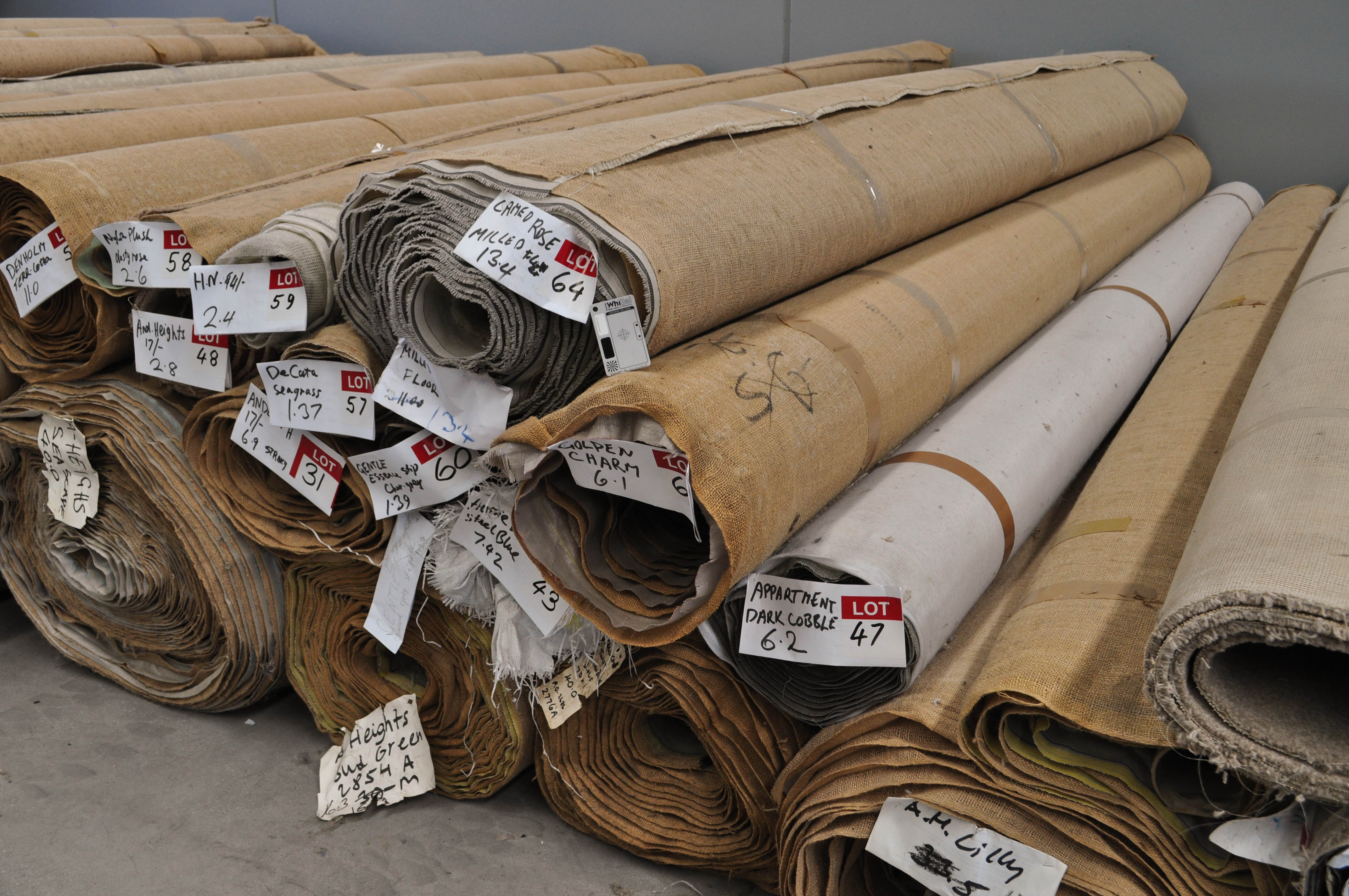
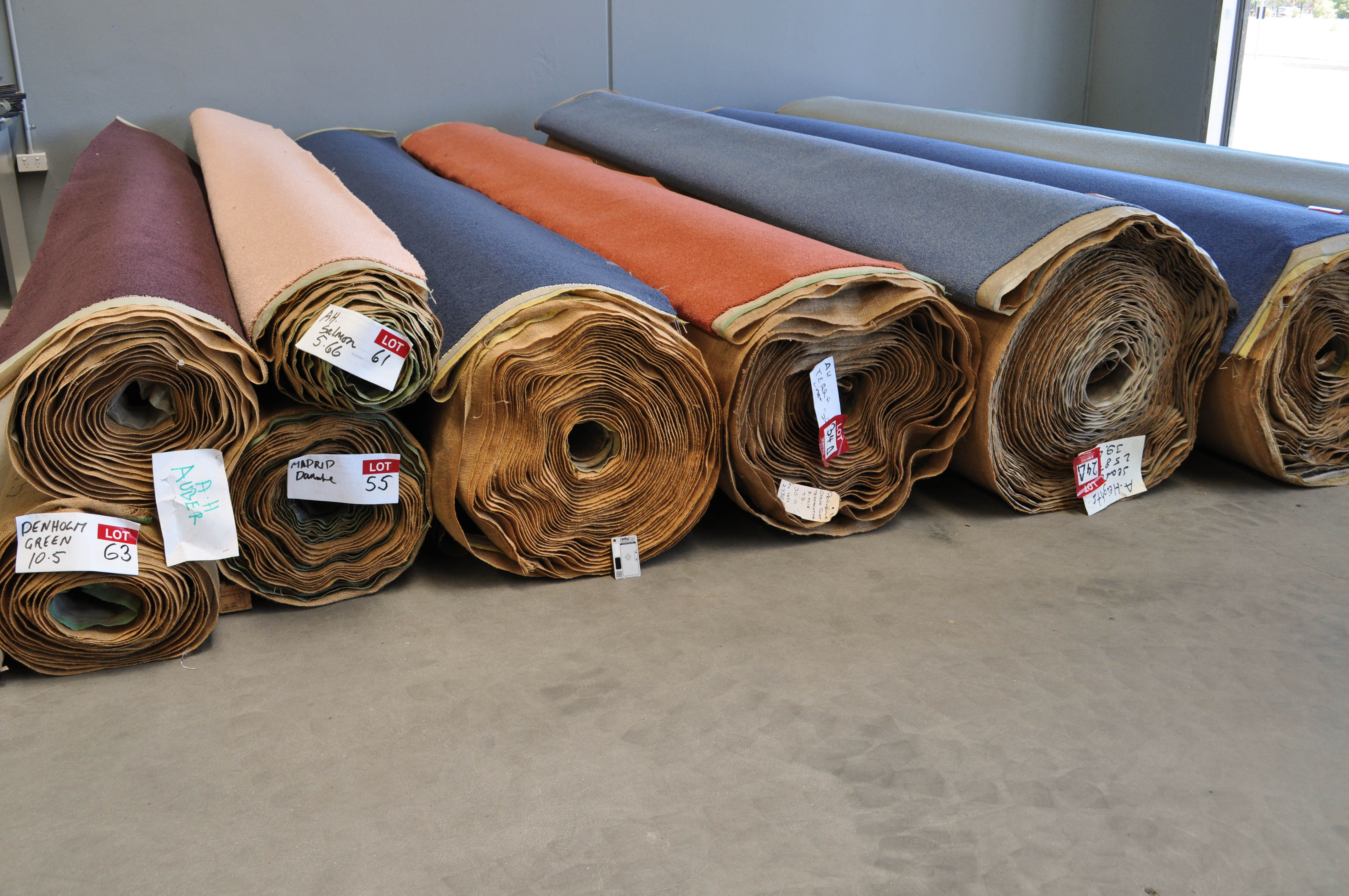


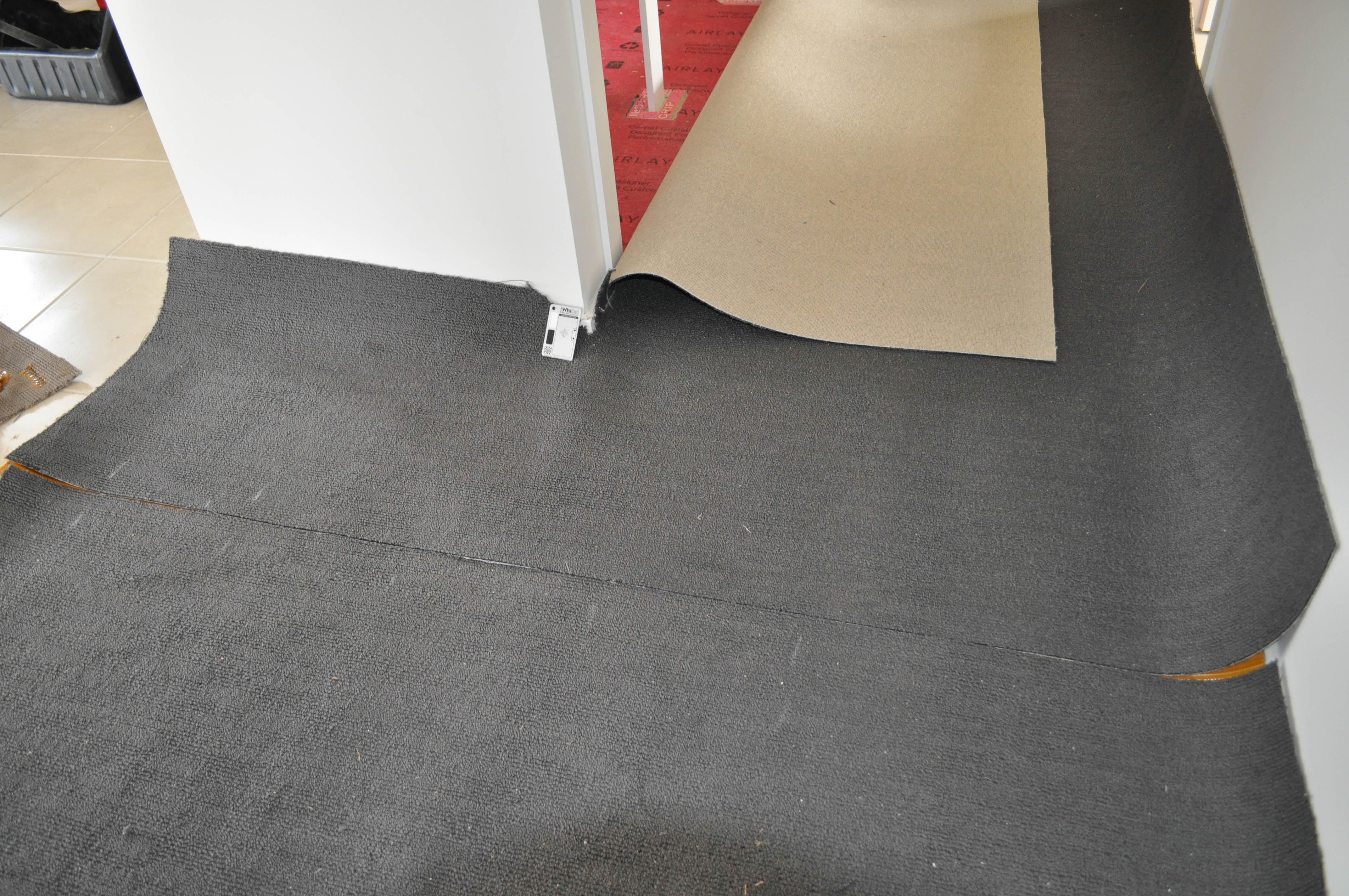
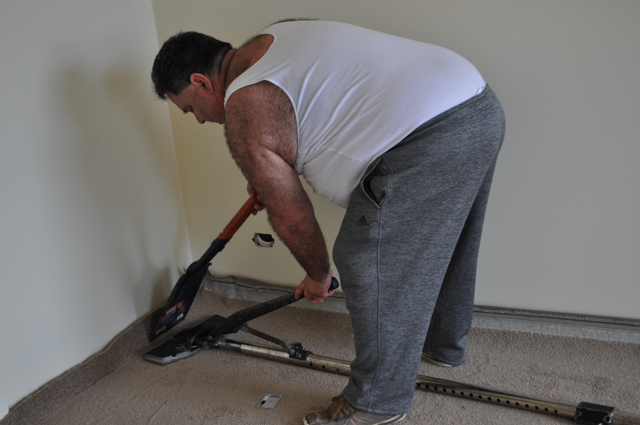
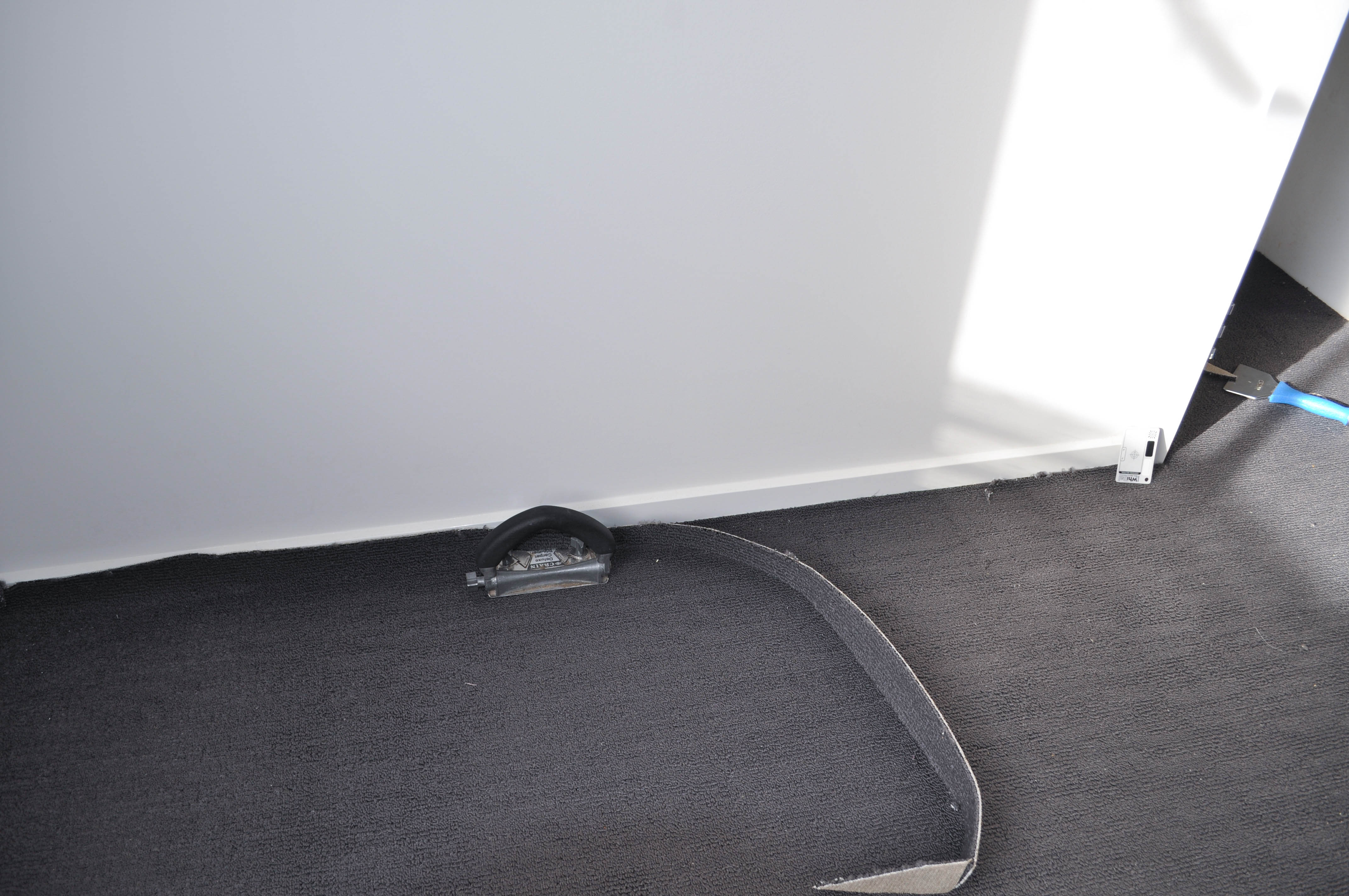
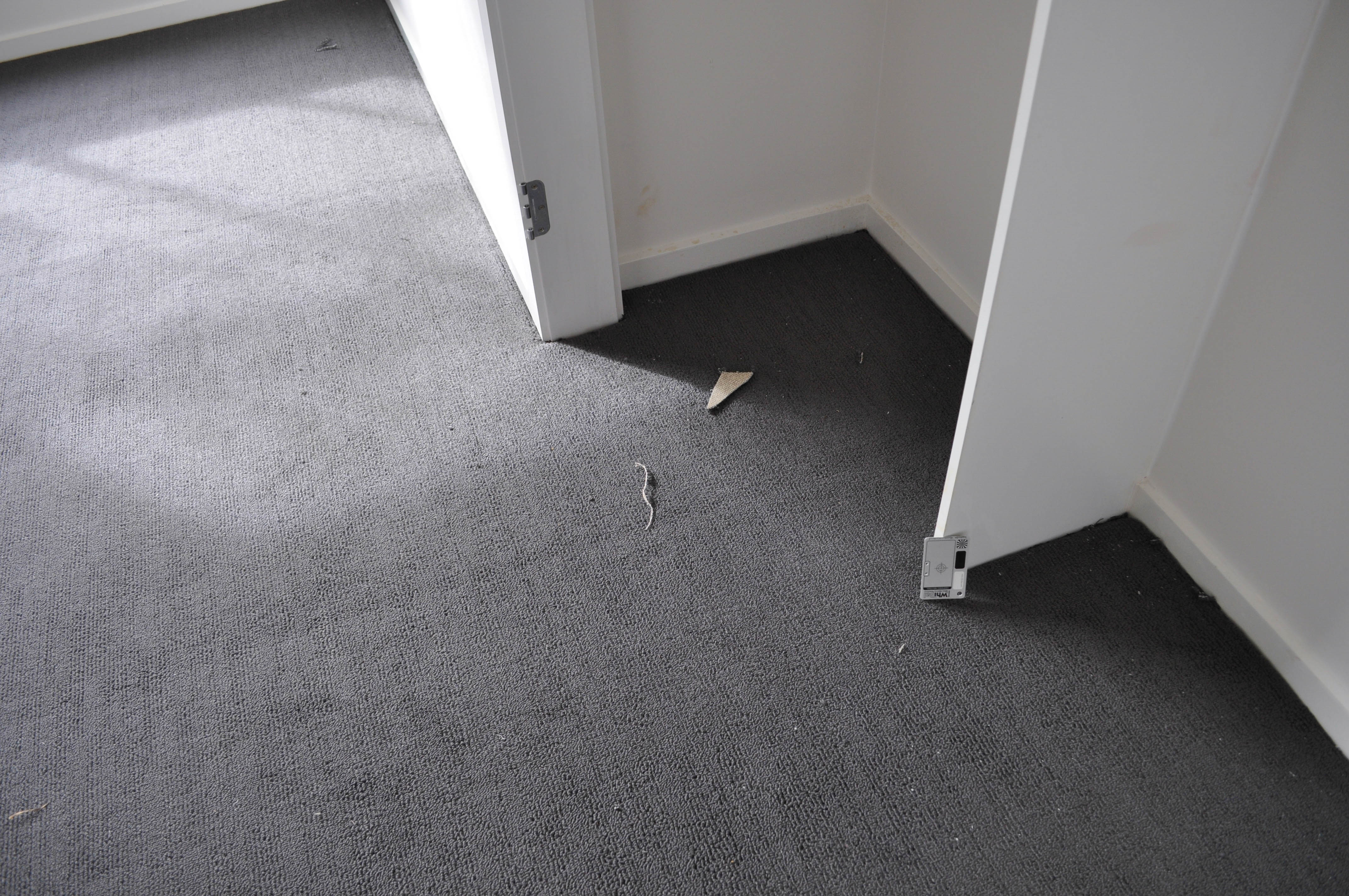
Once you give the green light to Concord Floors to proceed with the job, the carpet is ordered and cut to size and delivered to your premises. The gripper is put down and the underlay. The pre-cut rolls of carpet are placed on the laid underlay and stretched for tension. The bodies of different slabs of carpet are joined to make one continuous body of carpet.
The excess carpet running up the wall is trimmed, the scraps of off-cuts of carpet are collected and the carpet can now be vacuumed.
Where Carpet installation is carried out?
Carpet installation is a component of the floor coverings of buildings. As a result it is traded all over the world and Australia and Melbourne and western parts of Melbourne.
Where does Concord floors conduct a Carpet installation service?
Concord floors trades in carpet installation that is: the sale, supply and carpet laying of carpet flooring in the following areas: all suburbs of melbourne Victoria such as: St Albans, Deer Park Caroline Springs Werribee, Hoppers Crossing. For a complete list see Locations we service
In the year 2004 the government of Victoria passed in the Victorian Parliment, an Act called " Occupational Health and Safety Act 2004". This name is abbreviated often to "OHS". You can purchase or download this Act.
The National Code of Practice for induction for Construction Work defines construction work as: "any work on or in the vincinity of a construction site carried out in connection with the construction, alteration, conversion, fitting out, commissioning, renovation, repair, maintenance, de-commissioning, demolition or dismantling of any structure and includes......" Carpet laying is covered by this definition and comes under the Act's jurisdiction.
You must comply with this Act's requirements if you wish to stay on the right side of the law. Should an accident occur on your site or it's vicinity, you must report this accident immediately to the relevant authorities. They will then proceed with the matter along their established guidelines, which could involve a full investigation. In the worst case scenario you could lose your home and even more, and consequentally be bankrupted.
the "Occupational Health and Safety Act 2004" is the cornerstone of legislative and administrative measures to improve Occupational Health and Safety in Victoria. The Act sets out key principles, duties and rights in relational to occupational health and safety.The geneal nature of the duties imposed on parties participating in construction work, by the Act, means that they cover a wide range of circumstances. They do not readily date and provide considerable fexibility for the duty holder to determine what needs to be done to comply.
The Occupational Health and Safety Regulations 2017 are made under the Act. They specify the ways duties imposed by the Act must be performed, or prescribe procedural or administrative matters to support the Act, such as requiring licenses for specific activities, keeping records, or notifying certain matters.
They provide practical guidance to those that have duties or obligations under the OHS Act. They aim to provide easy to understand information on how to comply. This information, if applied appropriately, will mean those who follow it are deemed to have complied with their obligations under the OHS Act.
Duty of care- the owner and carpet installer and carpet retailer, have a "duty of care" to do everything reasonably practical to protect others and everybody, from harm in the workplace.
This "duty of care" extends to the owner's selection of personnel staff. Only staff that have been trained in the principles of OHS IN AN ACCREDITED COURSE, are allowed on site by law.
If we take a look at the photos below of three different interior decor styles of these homes, where Concord Floors laid the carpet, you will be drawn by one of them more than the others.


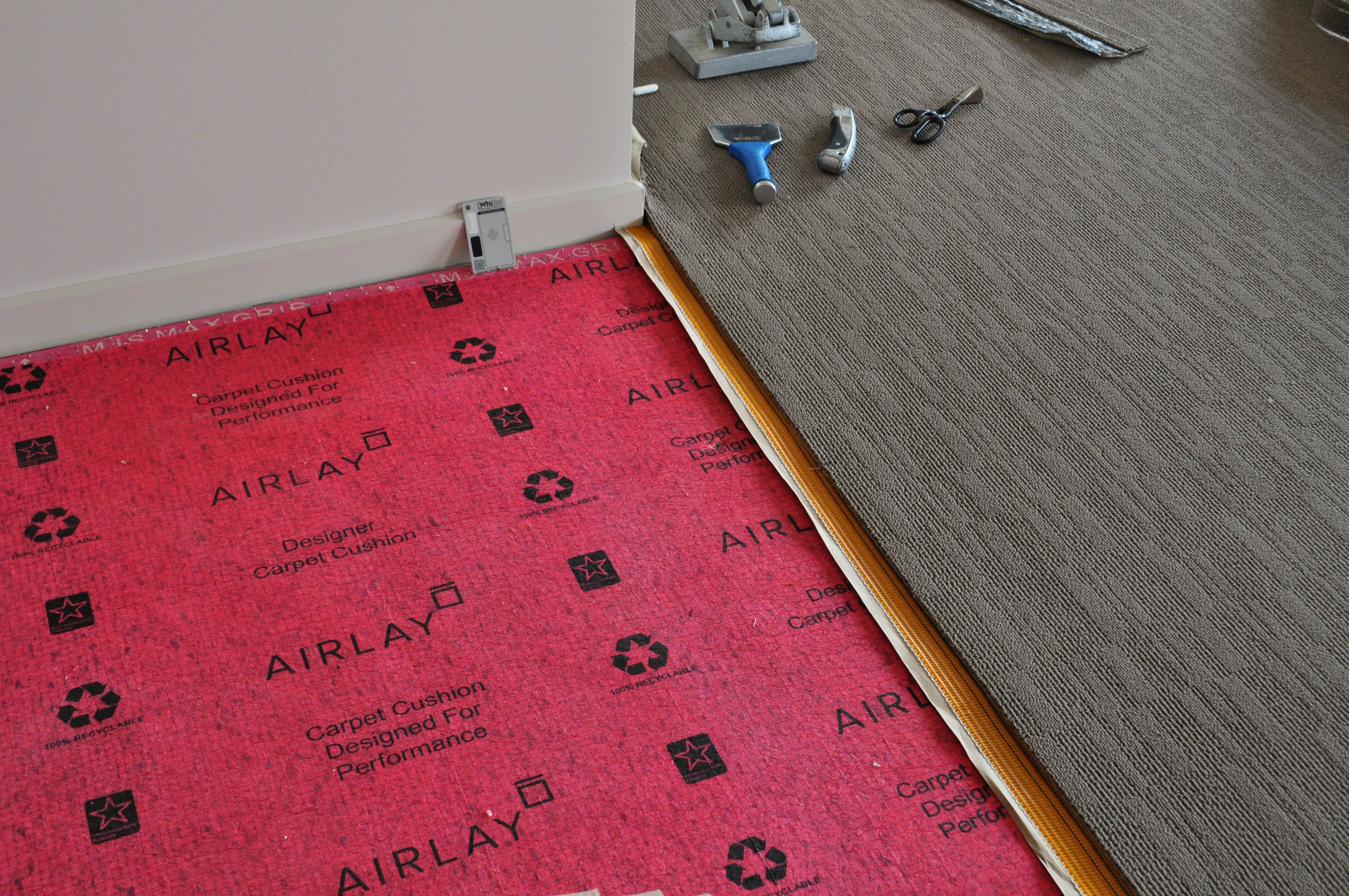
All of the three interiors look beautifull but which is the most appealing to you depends on your personal tastes. There are no right or wrong answers in interior decoration.
For a discussion on colors and home interior design, should you be interested, even if it is just to confirm your own ideas, please go to our home interior design section. Here you should find readily understandable principles and rules for building a pleasing balanced harmonious interior color scheme. But as I have said the right color scheme for you is the one that you find the most appealing. HOME INTERIOR DESIGN
This subject is discussed in the carpet section CARPET
Carpet installation cost has the the following components: the cost of the carpet, the cost of the carpet underlay, the cost of taking up and disposing of the existing carpet and underlay, the cost of furniture shifting to make carpet laying possible, the cost of an independent carpet layer to lay the underlay and carpet.
For information about carpet styles and their terminology please see Carpet and go to the section CARPET FLOOR: STYLES, YARN FIBRES and TERMINOLOGY
The cheapest underlays cost about $4.50 per square metre and the expensive $10.00 per square metre
To convert to the broadloom metres from square metre multiply by 3.6. The cheapest underlays cost about $16.20 per broadloom metre and the expensive $36.00 per broadloom metre
It is best to get an exact price from a proffessional carpet layer by way of a quote. This should be done by him after siting the job as there are many variables. Some of these variables are: Does he have to hammer in the gripper to a concrete floor or timber floor, how old is the concrete slab (concrete gets harder with time), will the floor be ready for carpet laying or will he have to takeup the existing materials, is there furniture that you would like him to move around, does he have to install underlay as well, etcetra.
But to give you some idea:
Currently in the Western Suburbs on a light weight carpet;
CARPET INSTALLATION PRICES are the sum total of the cost of materials (carpet + underlay + trims + gripper + adhesive tape) and carpet laying cost and any cost of travel time if applicable.
based on inexpensive polypropylene carpet, where the furniture and existing floor coverings have been removed, and room is of 3.6 by 4.00 dimensions.
Cost to carpet 1 bedroom = about $400.00
Cost to carpet 2 bedroom = about $800.00
Cost to carpet 3 bedroom = about $1200.00
Cost to carpet 4 bedroom = about $1600.00
based on dyed polyester carpet carpet, where the furniture and existing floor coverings have been removed, and room is of 3.6 by 4.00 dimensions.
Cost to carpet 1 bedroom = about $480.00
Cost to carpet 2 bedroom = about $960.00
Cost to carpet 3 bedroom = about $1440.00
Cost to carpet 4 bedroom = about $1920.00
based on dyed nylon carpet, where the furniture and existing floor coverings have been removed, and room is of 3.6 by 4.00 dimensions.
Cost to carpet 1 bedroom = about $580.00
Cost to carpet 2 bedroom = about $1160.00
Cost to carpet 3 bedroom = about $1740.00
Cost to carpet 4 bedroom = about $2320.00
based on wool carpet3 where the furniture and existing floor coverings have been removed, and room is of 3.6 by 4.00 dimensions.
Cost to carpet 1 bedroom = about $704.00
Cost to carpet 2 bedroom = about $1408.00
Cost to carpet 3 bedroom = about $2112.00
Cost to carpet 4 bedroom = about $2816.00
Part of the installation process is the laying of the carpet. There aren't many top gun carpet layers left- most have retired or left the industry. The rewards for carpet laying work is not generous, in fact they are underpaid. With the exodus of top layers the bulk of the layers left take short cuts in laying work to speed up the time it takes to finish a job. This is the same money earned in a short period of time. This is the same as more money earned per day. The result for you is most likely you could have had your carpet laid better. These are signs of tradesmanship in carpet laying:
Naturally the old existing carpet must be pulled up and disposed off before the new carpet can be installed.
Empty out your room of all furniture. Using a pair of pliers pull-up the carpet at one corner of the room. Continue pulling the carpet towards the centre of the room. Release the hold that you have and let it drop to the ground. Walk to the other corners of the room a repeat the process so that all the carpet is of the gripper.
Wrangle the carpet so that you can cut it straight into stripps.
Cut the carpet into stripps approximately 1.2 metres in width. Roll-up the stripps into a roll and tape the roll.
Take the carpet rolls out of the room
Inspect the underlay and determine whether you want to change it as well. if you do simply roll up the slabs of underlay into rolls and tke out of the room.
Dispose of the carpet rolls and carpet underlay at your local tip.
STRETCHED-IN method---here smoothedge (timber strips with short steel spikes protruding through the top side) are nailed around the edges of the room followed by the laying out of the underlay. The underlay may be of waffle rubber, foam or felt.
Step by step
If the house is tenanted, the first step is to shift out the furniture, and scrap,clean and sweep the floor.
If it is a new home clean out the rubbish that is leftover from construction, then scrap and clean the floor.





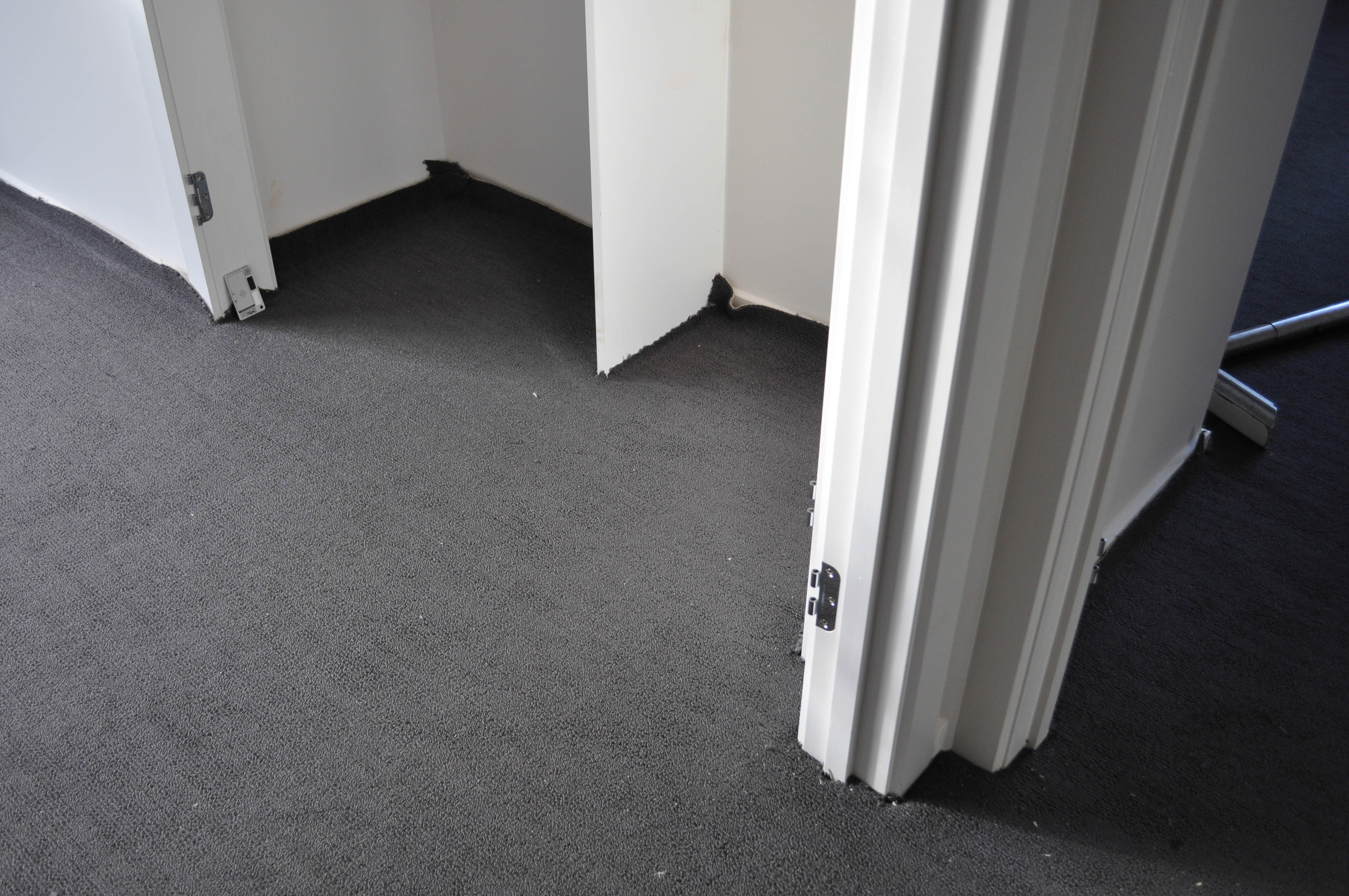






Pull out the tiling wedges that are supporting the tiles and slabs of plaster or timber supporting the skirting boards, in order that the carpet gripper can sit evenly and proudly on the concrete slab.
Sweep and if possible vaccuum the floor.
To assist you, remove the doors in order for them to not be an abstacle to the laying process.
If it is a timber floor, check for protruding nails and hammer them home, blobs of plaster, scrap them away. If left they will be felt underfoot when you walk over the carpet
Check that the slabs of particle board flooring aren't cupping at their edges. If they are use an edge sanding machine to sand off he peaks to level the floor.
Where there is a difference in height in the particle board flooring insert a sheet of plywood to raise to the same level and sand down the plywood to make a gentle gradient of transition
Throw down the gripper (term: smoothedge in the trade) (the orange timber sticks in the photos) around the edges of the room.

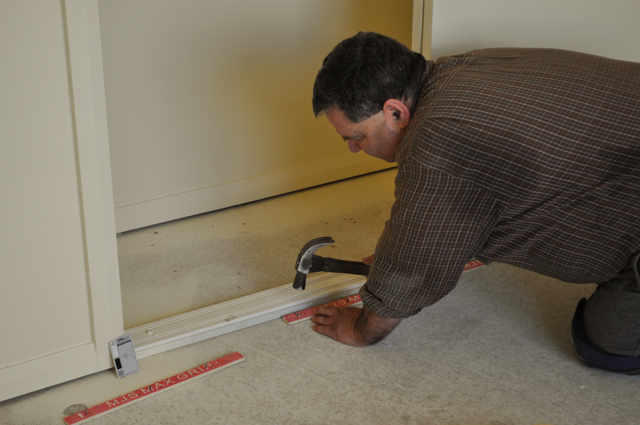
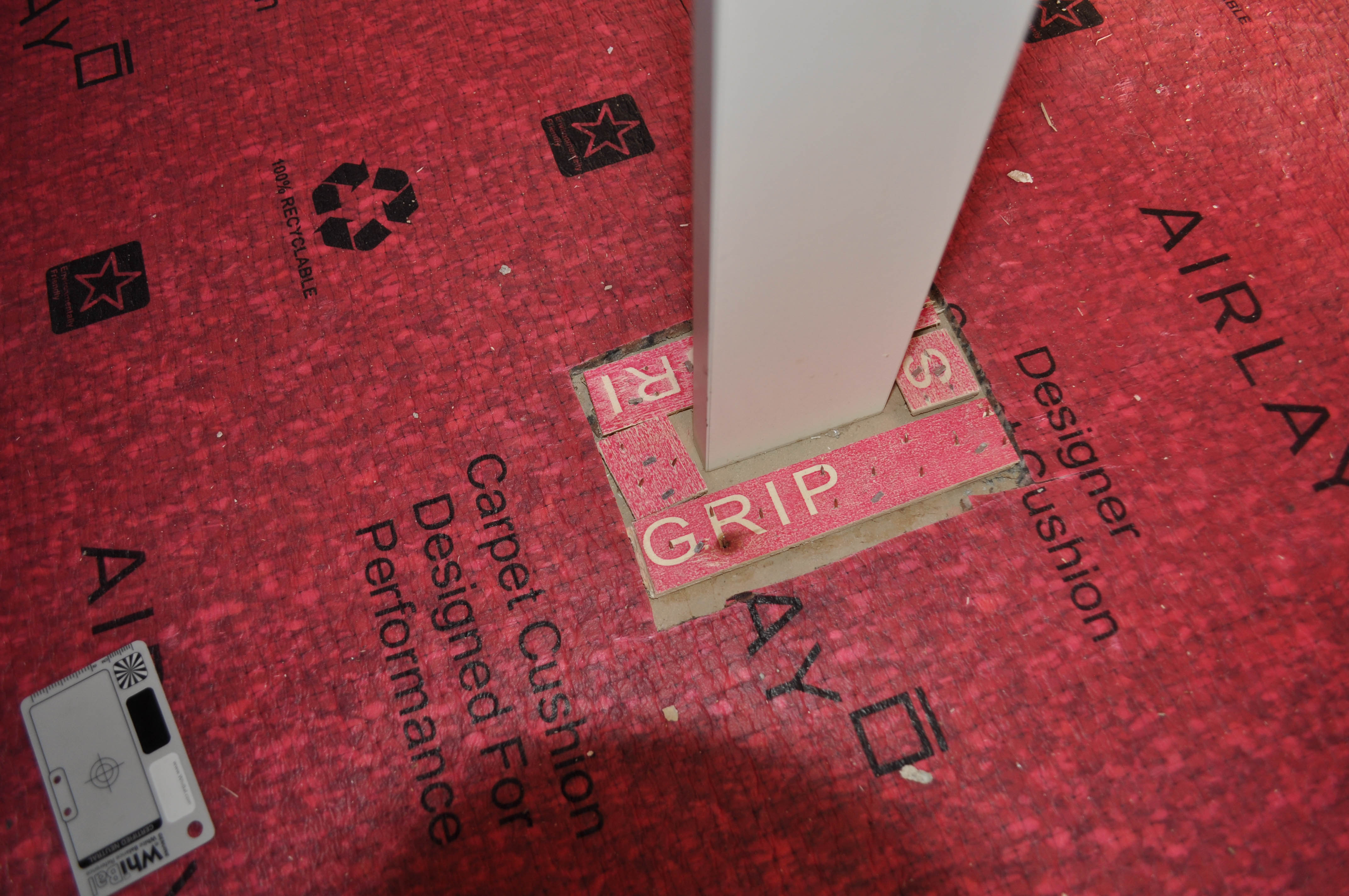
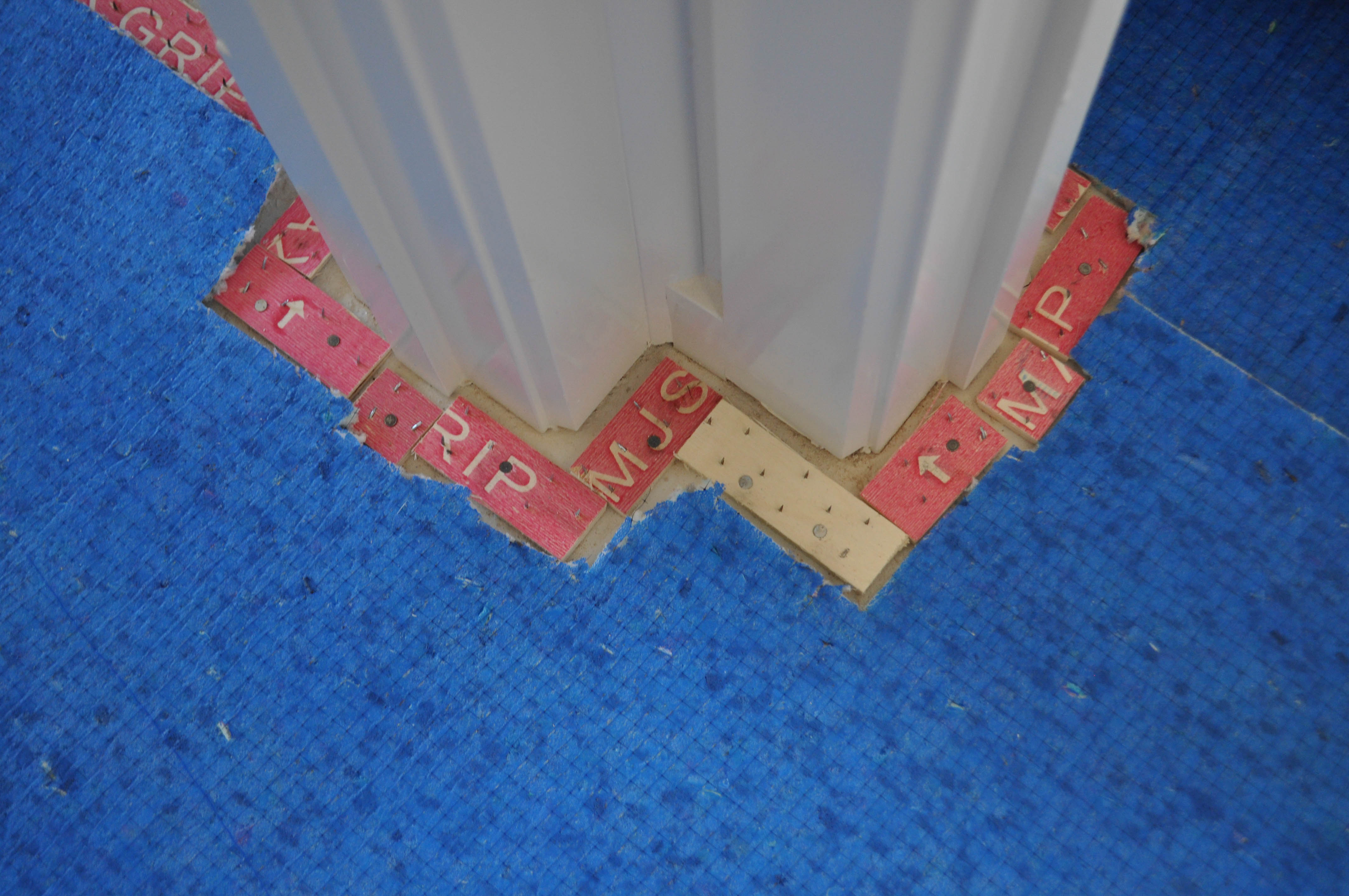

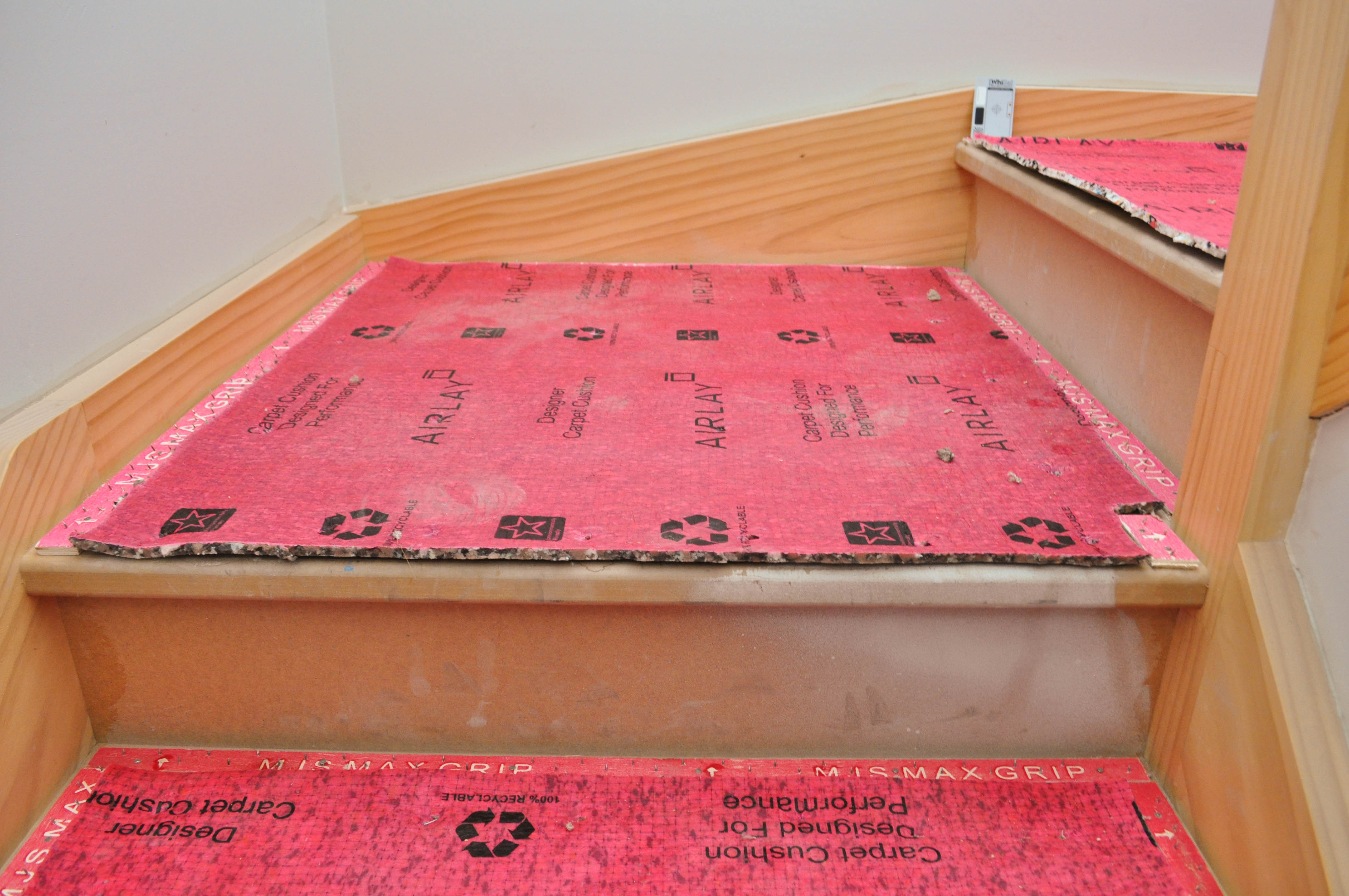
Hammer down home the gripper concrete nails into the concrete slab. Position the gripper on the floor so that the gripper's side closest to the wall is a constant a 5-8mm from the wall's skirting boards.
install the gripper right around the door jambs and wardrobe partition particle boards, wardrobe sliding tracts, always leaving a maximum 5-8mm gap (the crotch). This crotch should be one continous line. Into this crotch the carpet will be tucked in after the carpet is trimmed
The same applies to smoothedging the steps in a staircase
install the underlay.
bring into the room, the roll of carpet that is going to be installed into this room, and throw it onto the floor and unroll it and trim it so it sits neatly and snugly agains the gripper.




Lift up the underlay and apply a latex adhesive to the concrete slab to bond the underlay to the slab. replace the underlay to it's original position. Wait 5 minutes for the latex to grab before placing carpet on top of it. This ensures that the underlay won't move when the carpet is placed upon it and dragged, and generally moved when the carpet is being positioned and stretched during the carpet laying process.
If the substrate flooring is particle board flooring then afix the underlay to the particle board with staples with a staples applicator.
You are now ready to bring into rooms the rolls of carpet that has been cut to suit the lengths of the rooms
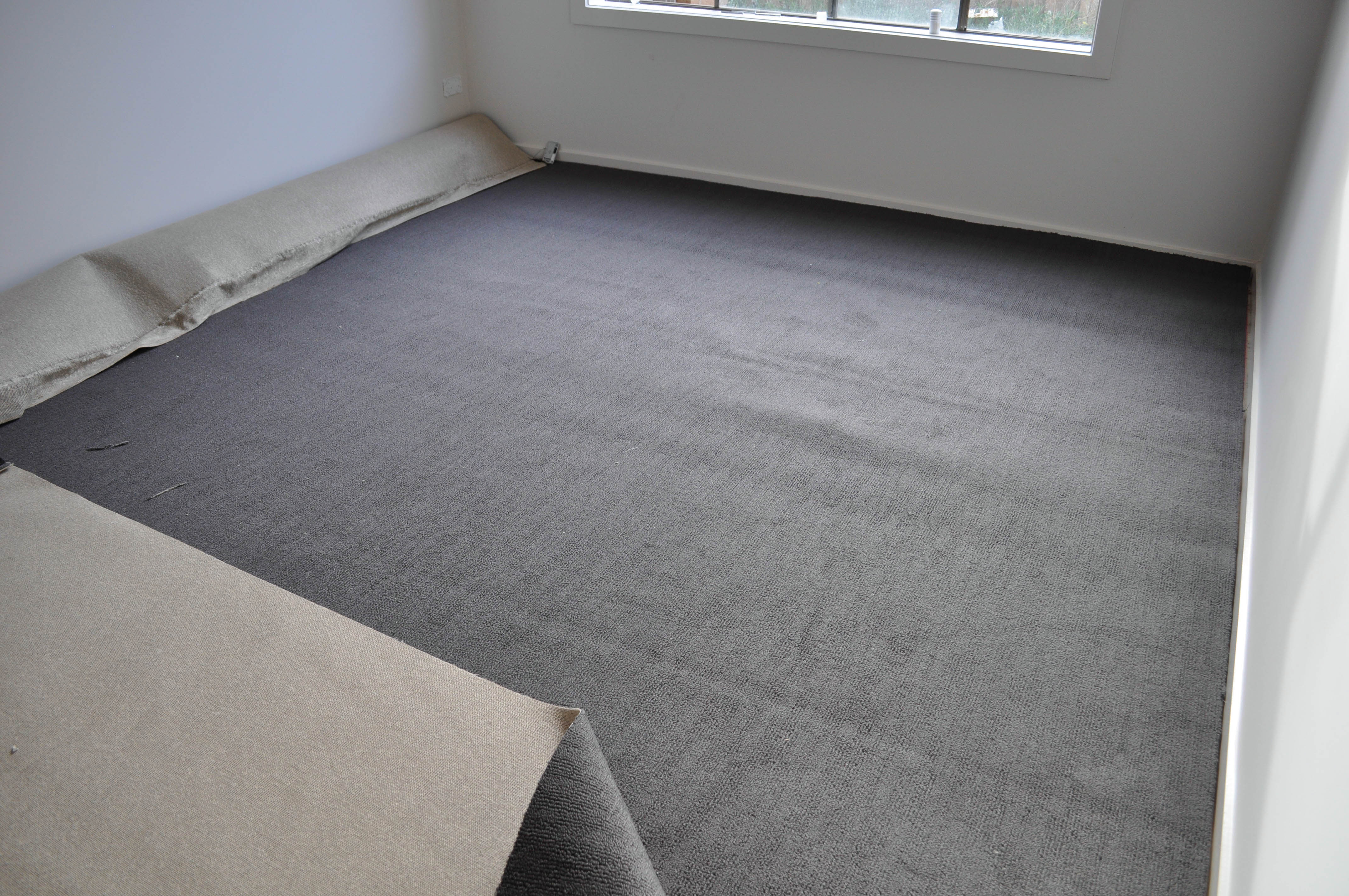

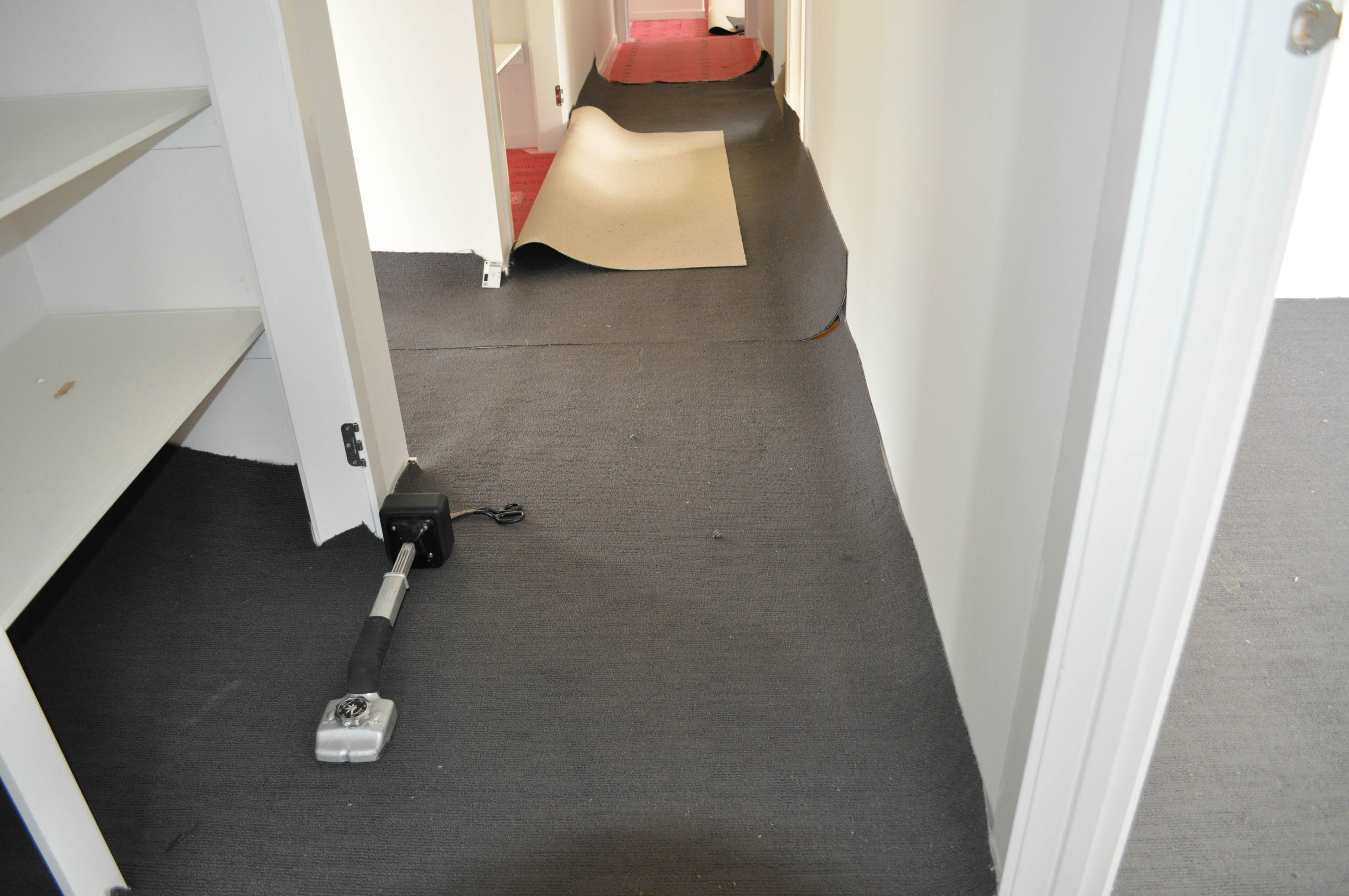
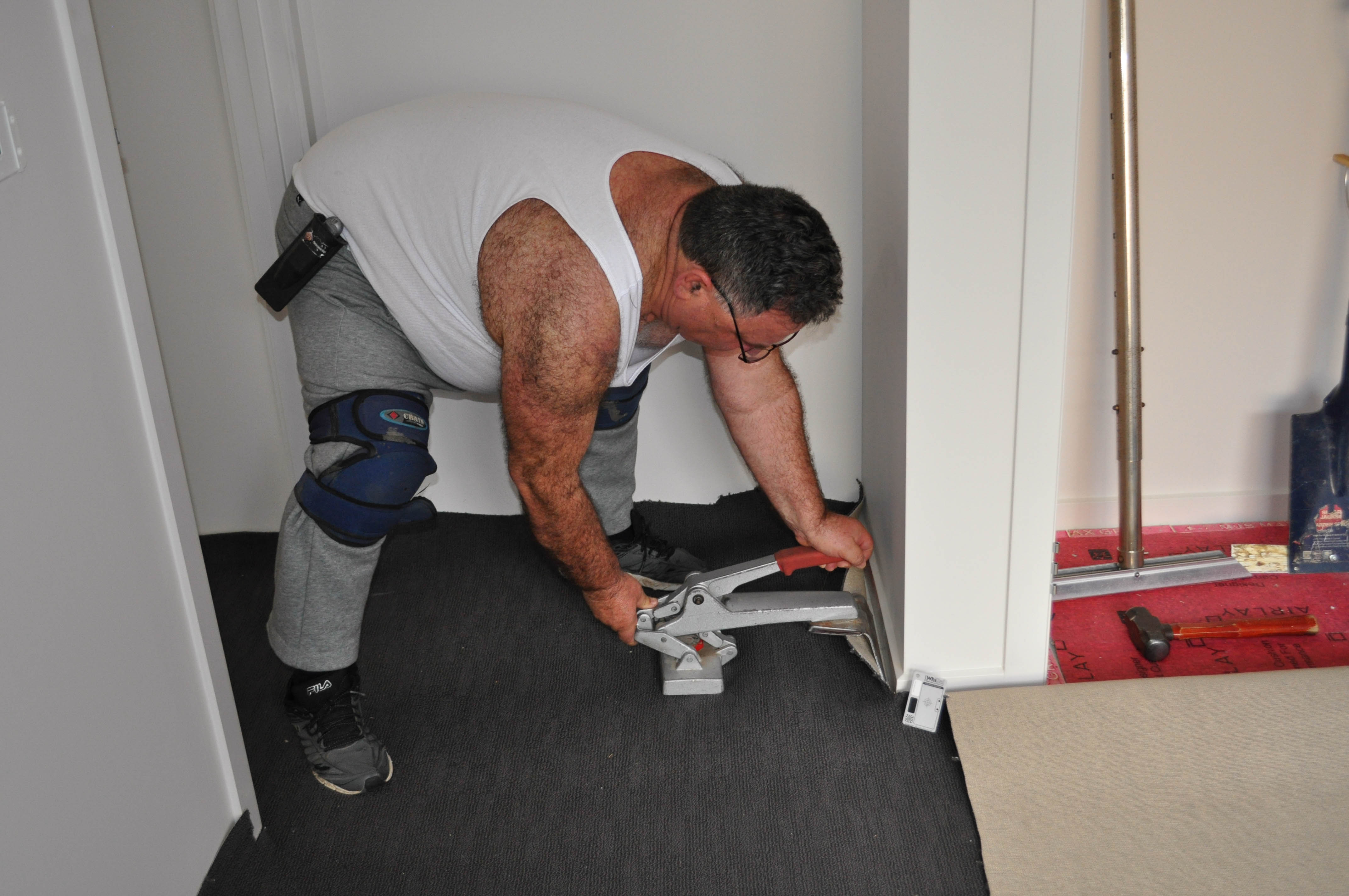
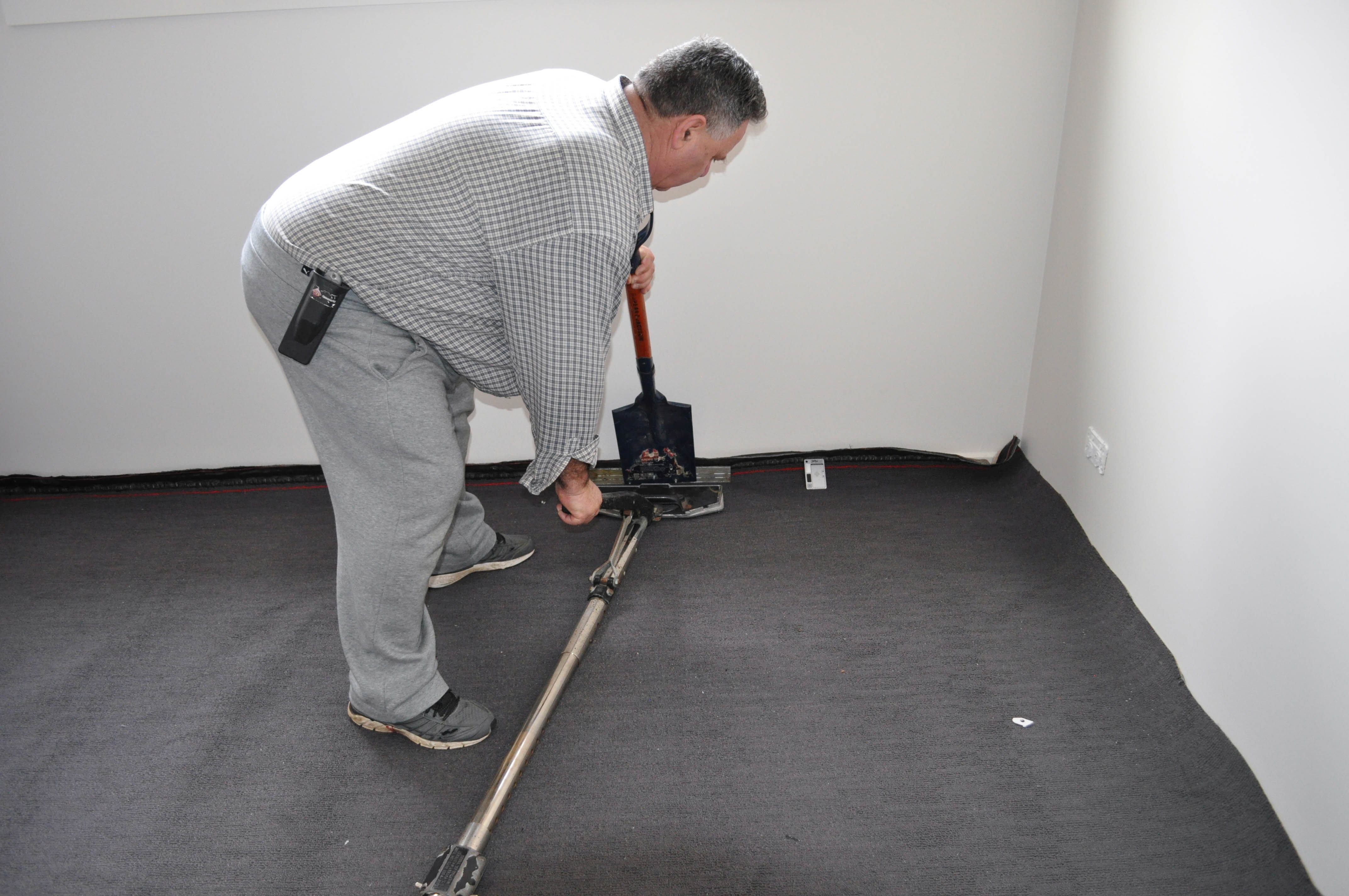
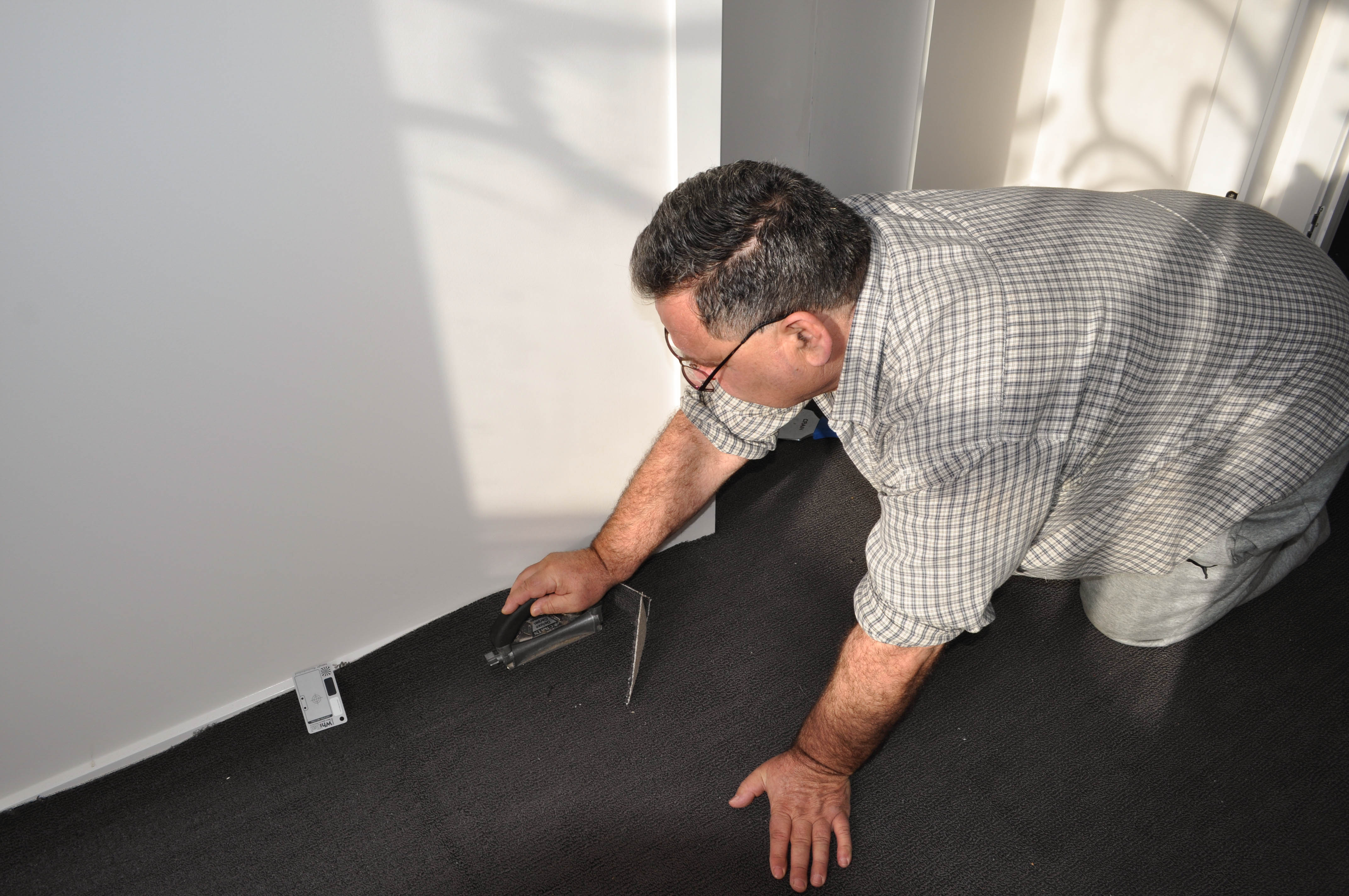
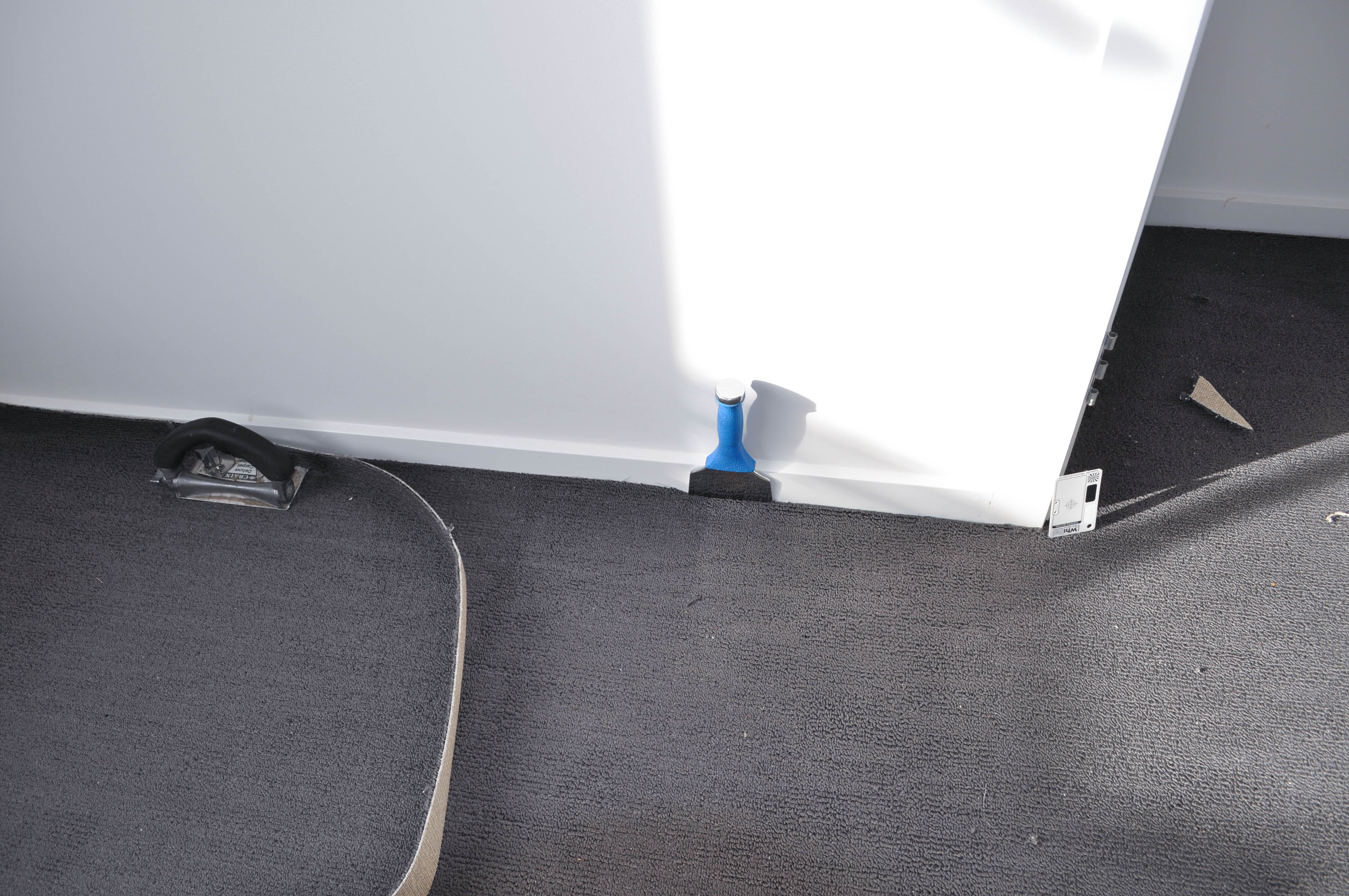

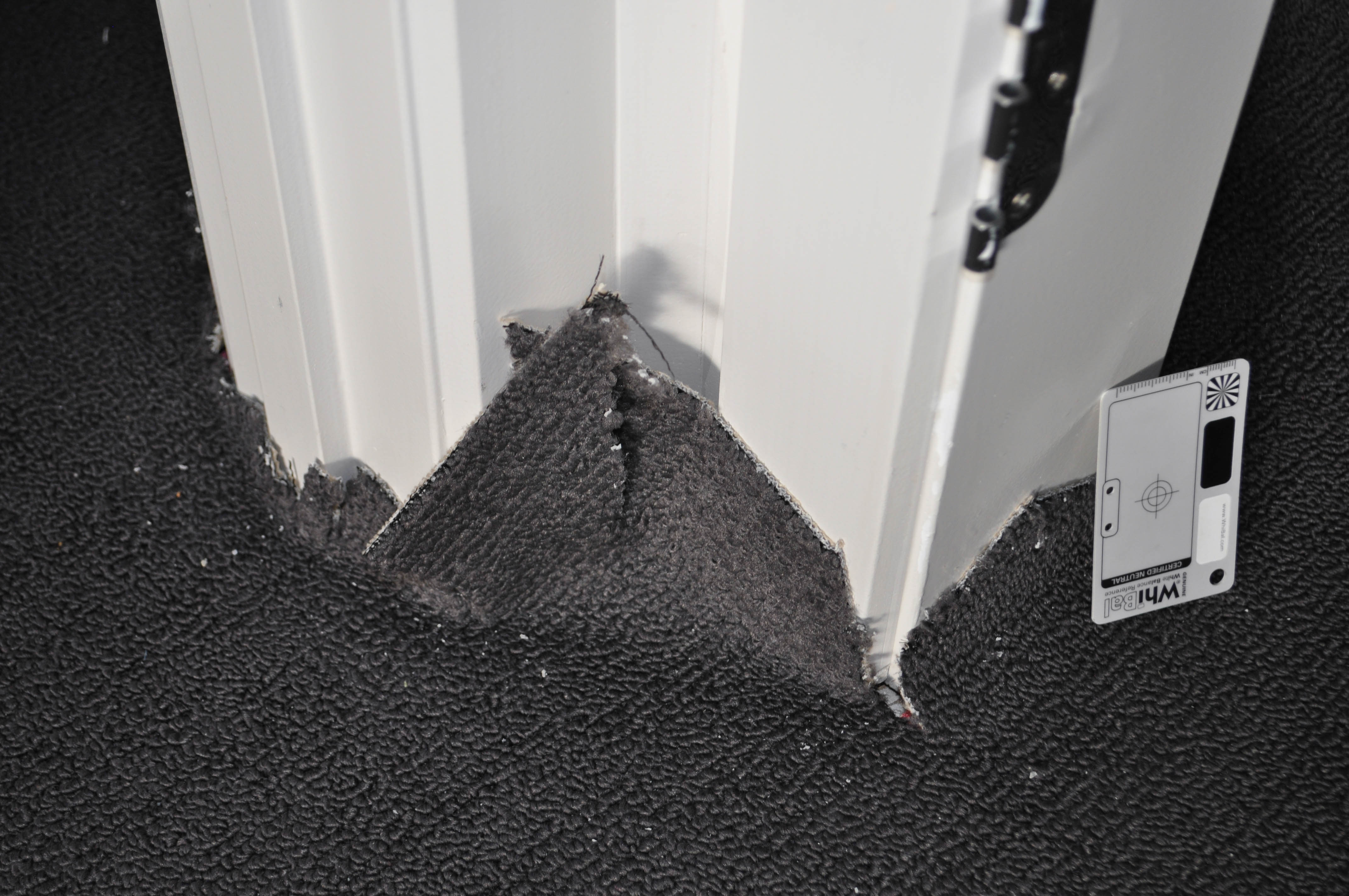
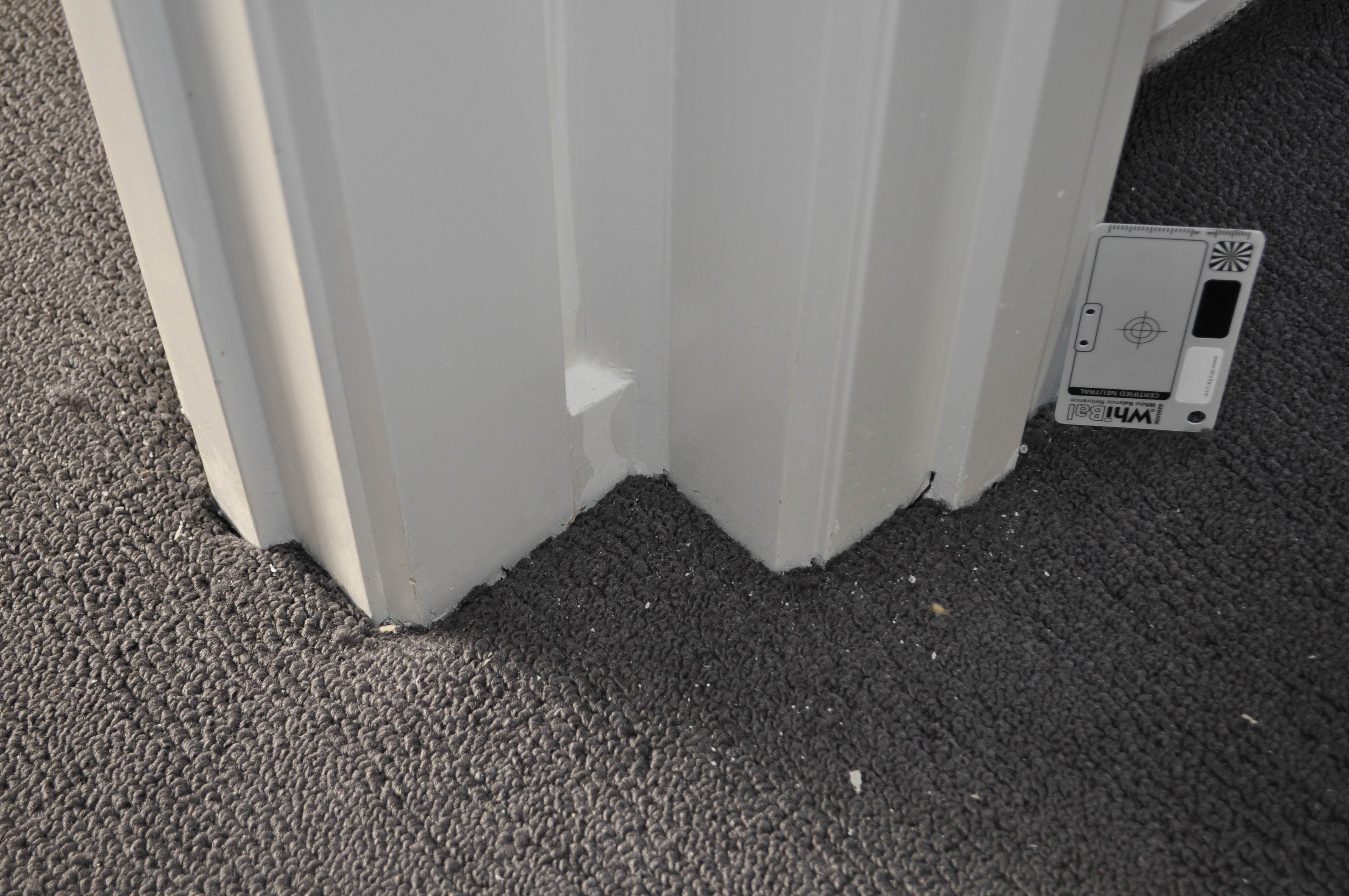
Cut the excess carpet (the overflow carpet running up the wall) leaving a minimum length of 2-12 mm running up the wall. Where the room isn't square or rectangular, such as the passage above, cut the carpet at the points of the room's demensional variations, or corners, always leaving the a minimum length of excess carpet of 2-12 mm running up the wwall.
if the carpet in the room is to join another slab of the same carpet in an adjoining room, or butts up to carpet in the same, then make certain that the pile of the two carpets lean in the same direction.
to test whether the pile is pointing in the same direction, brush your hand across a small portion the surface of both slabs of carpets and see (and feel in loop pile carpet) visually that they appear to be the same color.
The steps are illustrated by the picture below with their commentaries.
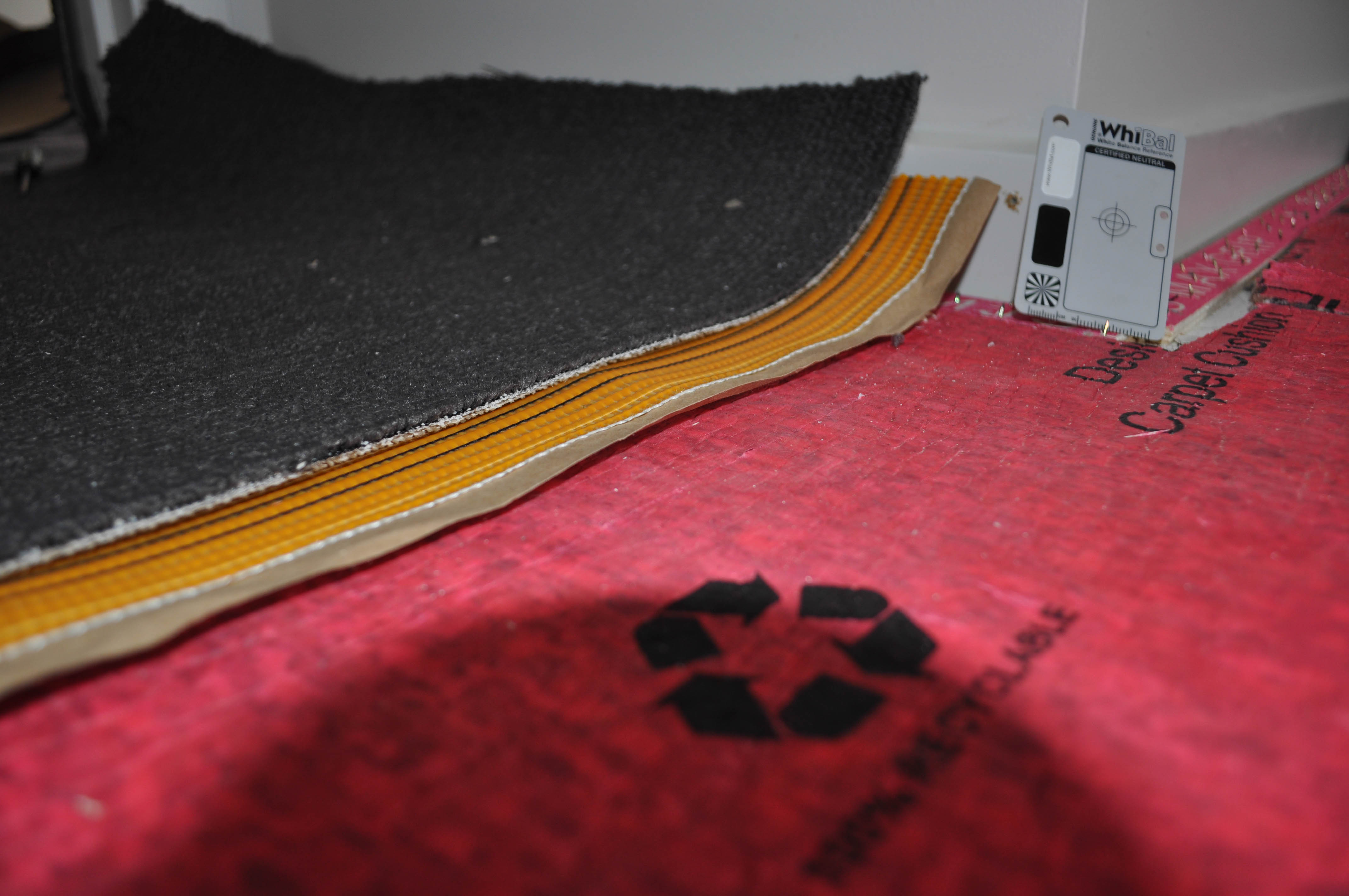
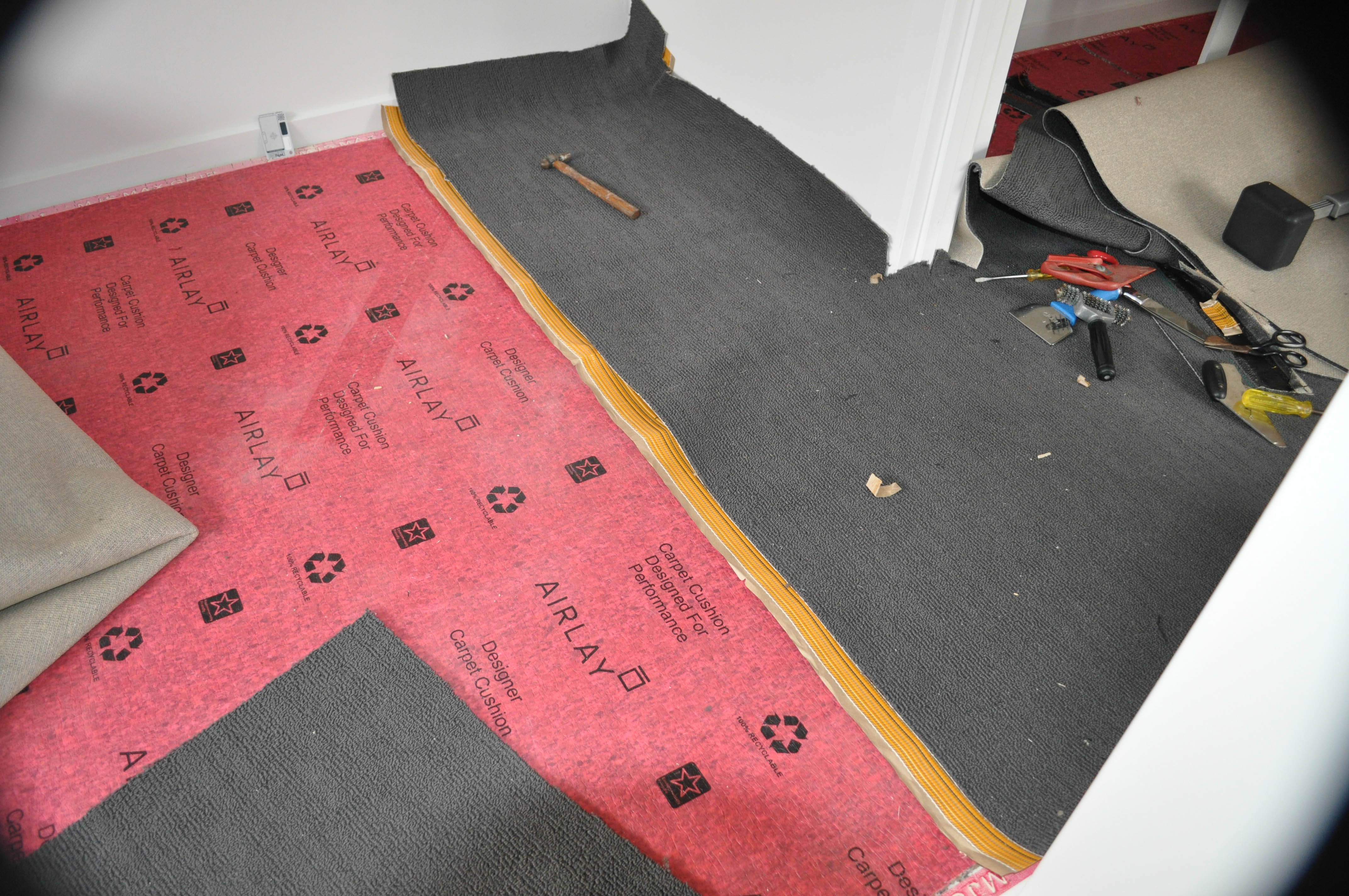
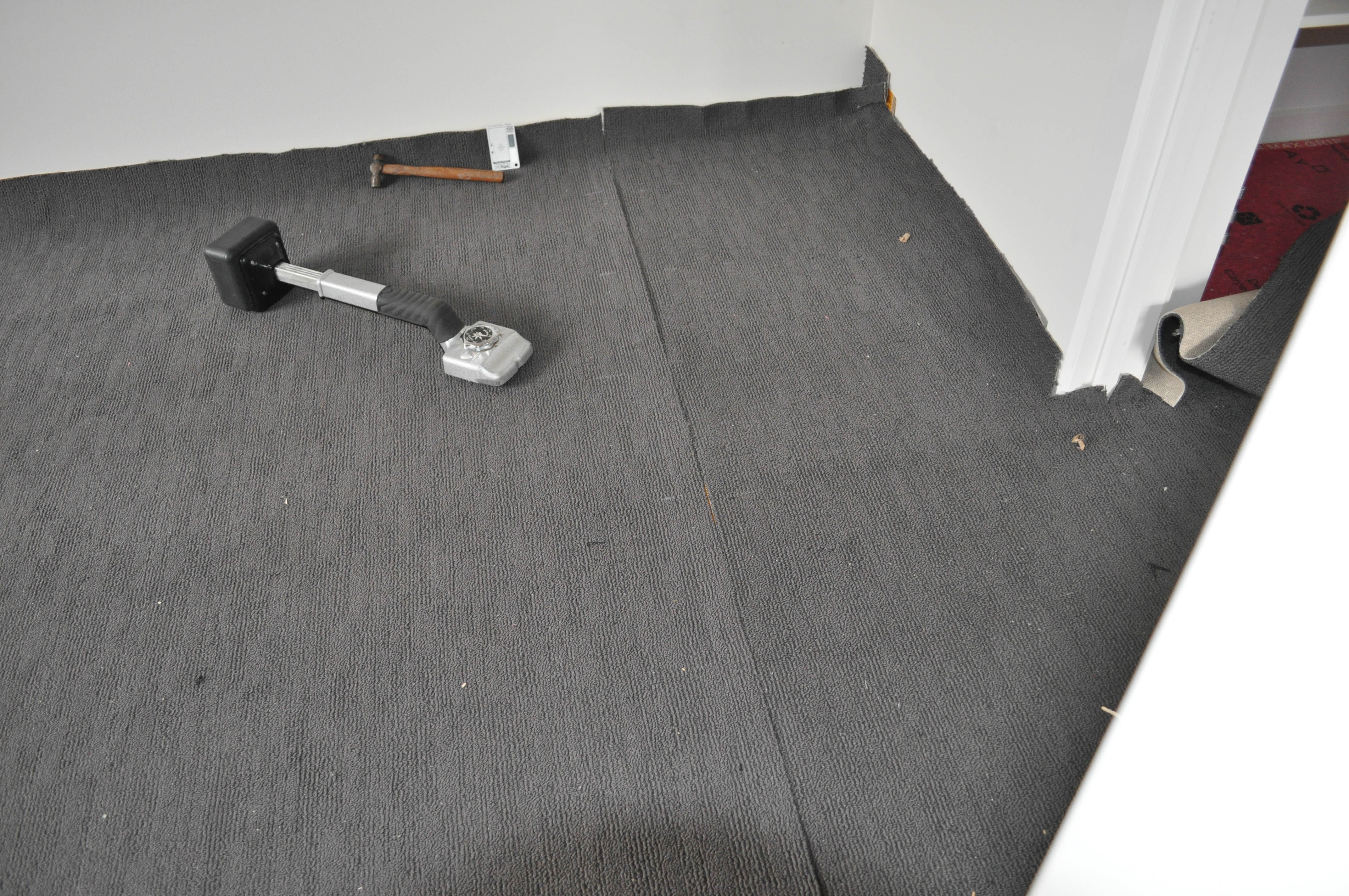

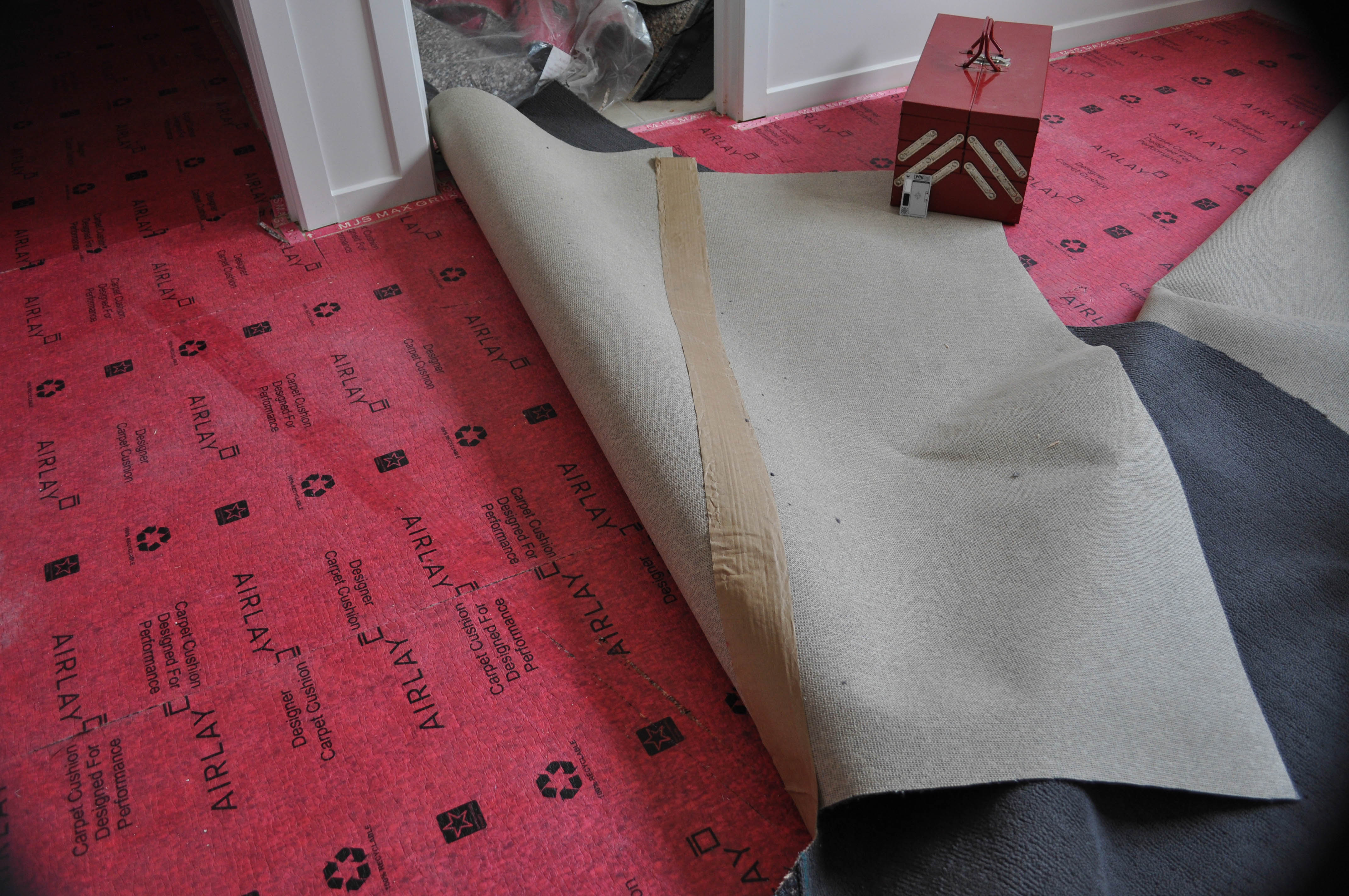
to join two bodies of carpet lengthwise, first cut both carpets where they meet and will be joined, evenly and in a straight line. To get a perfect join a carpet layer places onto the carpet pile where the join is to take place, a screwdriver at a 30 degree angle, runs the screwdriver through the pile, parting the pile and continues running the screwdriver from where the join is to start to finish.
now that he has made a staight line in the carpet he employs a carpet cutting tool to cut the carpet.
Position the two bodies of capet together, eliminating all gaps. Place underneath the carpet in the join area, the heat bond tape and using a carpetlaying heat bond iron melt the wax on the tape dragging a toolbox over the join as you go along.
Now that the carpet covers the whole floor in one piece in which the fillers have been joined, stretch the carpet using power stretchers or knee kickers. The bulldog power stretcher is in the fourth photo, and the telescopic power stretcher in the fifth. The knee kicker is the third photo.
trim the excess carpet that runs up the wall with a special carpetlaying trimming tool and stanley knife.
Where it isn't possible to use the trimmer especially around architraves, use your stanly knife
tuck in the trimmed carpet into the crotch with a carpet layer's stair tool.
collect the carpet scraps from the floor that result from the trimming and clean and vacuum the floor.
The job is done- mission accomplished.
DIRECT STICK ---Glue is applied to the substrate (concrete slab or other surface receiving the carpet) and then the carpet is stretched out over the glue. No underlay is used.
DUAL BOND SYSTEM--smoothedge may or may not be naile around the perimeter of the walls. Glue is applied to the concrete or timber substrate onto which underlay is spread. When the glue has cured and gripped the underlay a layer of carpet glue is spread over the top surface of the underlay. When this glue is "tacky" (ready to gripp the carpet) the carpet is spread over it and strecthed and trimmed to size. This system is used in large arpeet installations such as hotels. The advantages are it stops ripples forming with the use of the carpet. Rarely used in domestic homes.
Stairs may be layed according to the bullnosed method or the waterfall method.
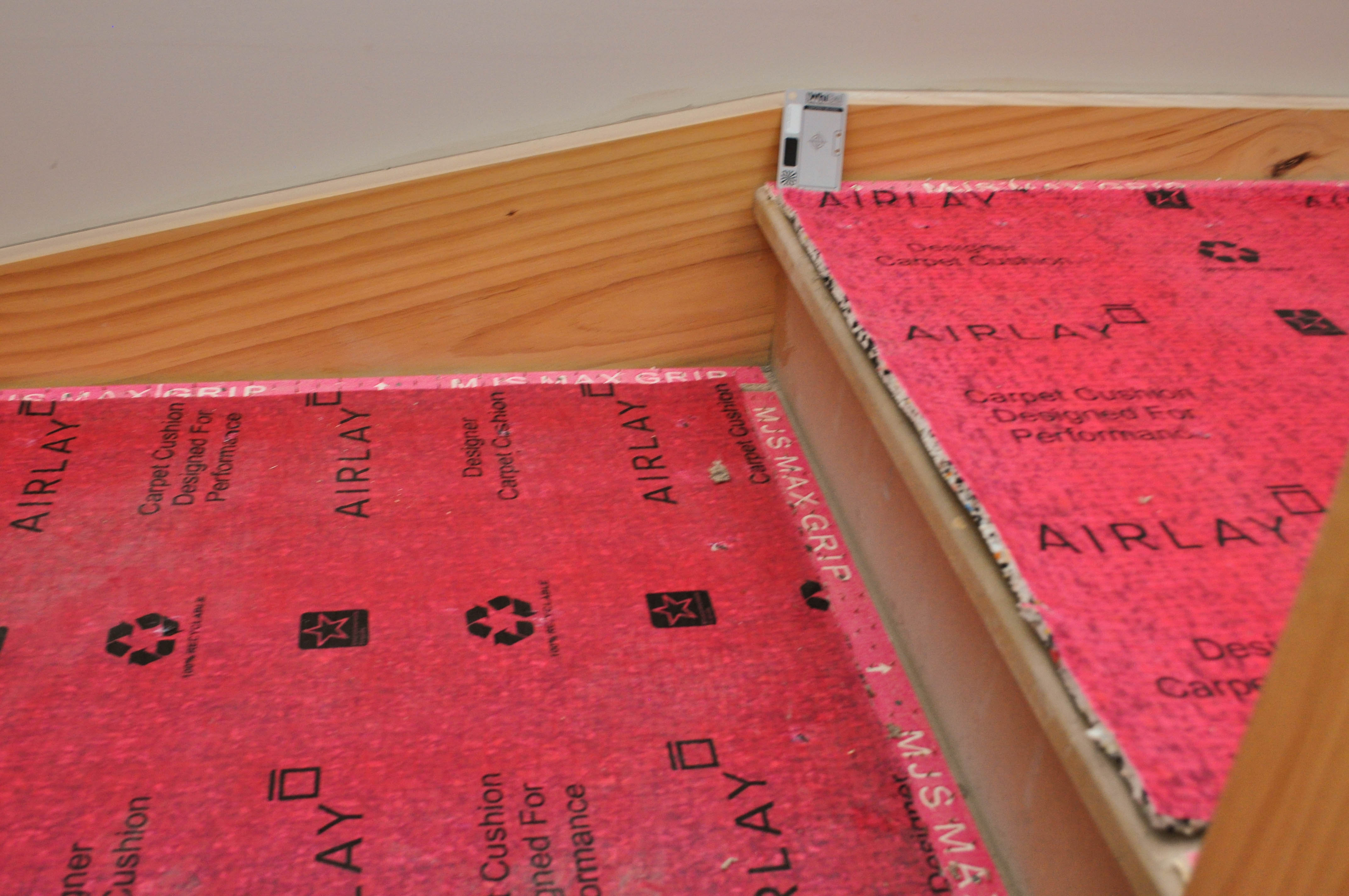


Cut to size the gripper and underlay and affix to steps.Cut the carpet to size and affix to the prepared gripper and underlay
position the bottom of the carpet at the bottom step and staple with the electric tacker. With the stairtool (blue handle) press the carpet with force underneath the lip of the step above and staple the carpet to hold position and permanently stay in that position. Do this across the entire step. With your knee kicker tense the carpet across the step directly away from the lip and onto the gripper. repeat across the entire step. with your stairtool and rubbeer mallet force the carpet into the crotch. after this has been done across the entire step staple with the electic tacker at the bottom of the next carpet riser right across the step.
Strech the carpet crosswise with power strecher to tense it. The finished staicase.





Over a period of time, a need for carpet restretching can arise after new carpet is installed in a home. With time, what can happen is the carpet bubbles or ripples though people walking on it. The mechanics of how a bubble or ripple forms in a carpet is as follows: every time a step is taken the foot presses on the carpet and underlay downwards and this movement maakes the carpet travel 2-6 millimetres towards the concrete slab of timber flooring (carpet substrate). The thicker the carpet underlay, the greater the length of the movement. When this carpet travels during this movement, it stretches a little and physically becomes wider or longer. Now carpet is a textile which doesn't behave like rubber which when stretched bounces back. Carpet doesn't bounce back when stretched. On the footfall of each footstep the carpet is stretched, tavels and expands and doesn't return to it's original size. Consequently it grows insize. The walls of the room stop it from travelling further, so the only thing that can happen to accommodate the increase in size is for the carpet to permanently move upwards and form a bubble or ripple.
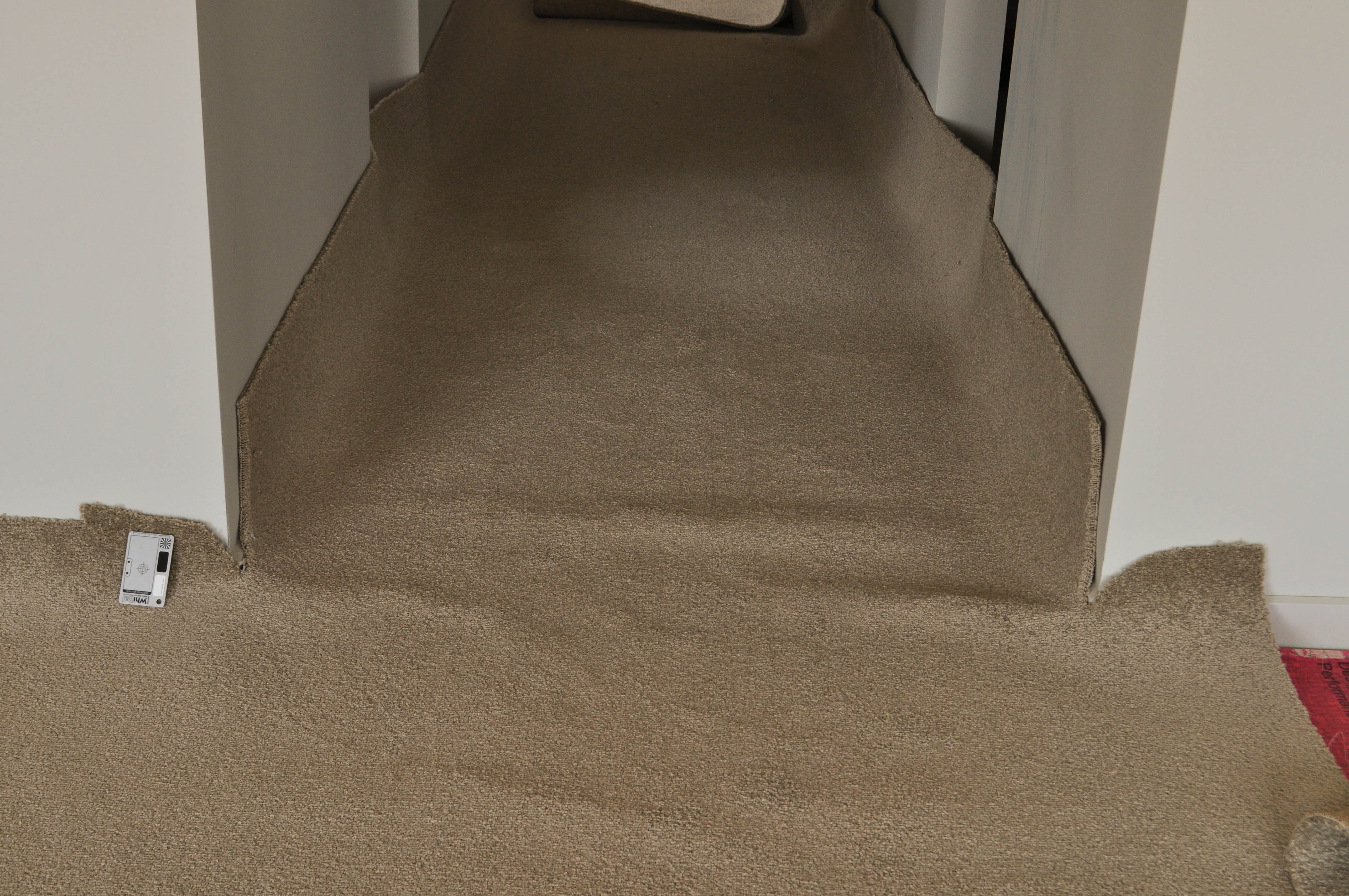
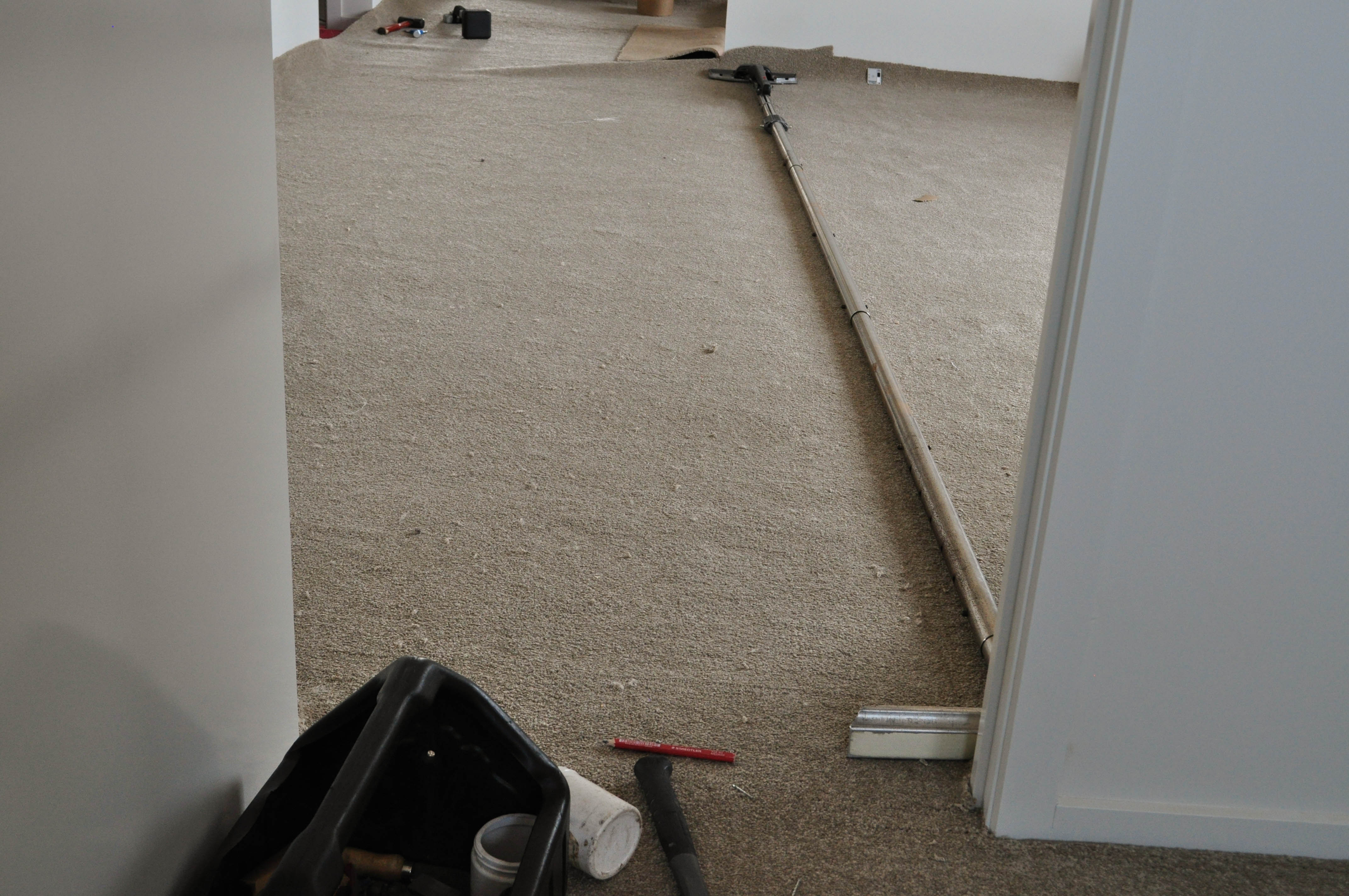



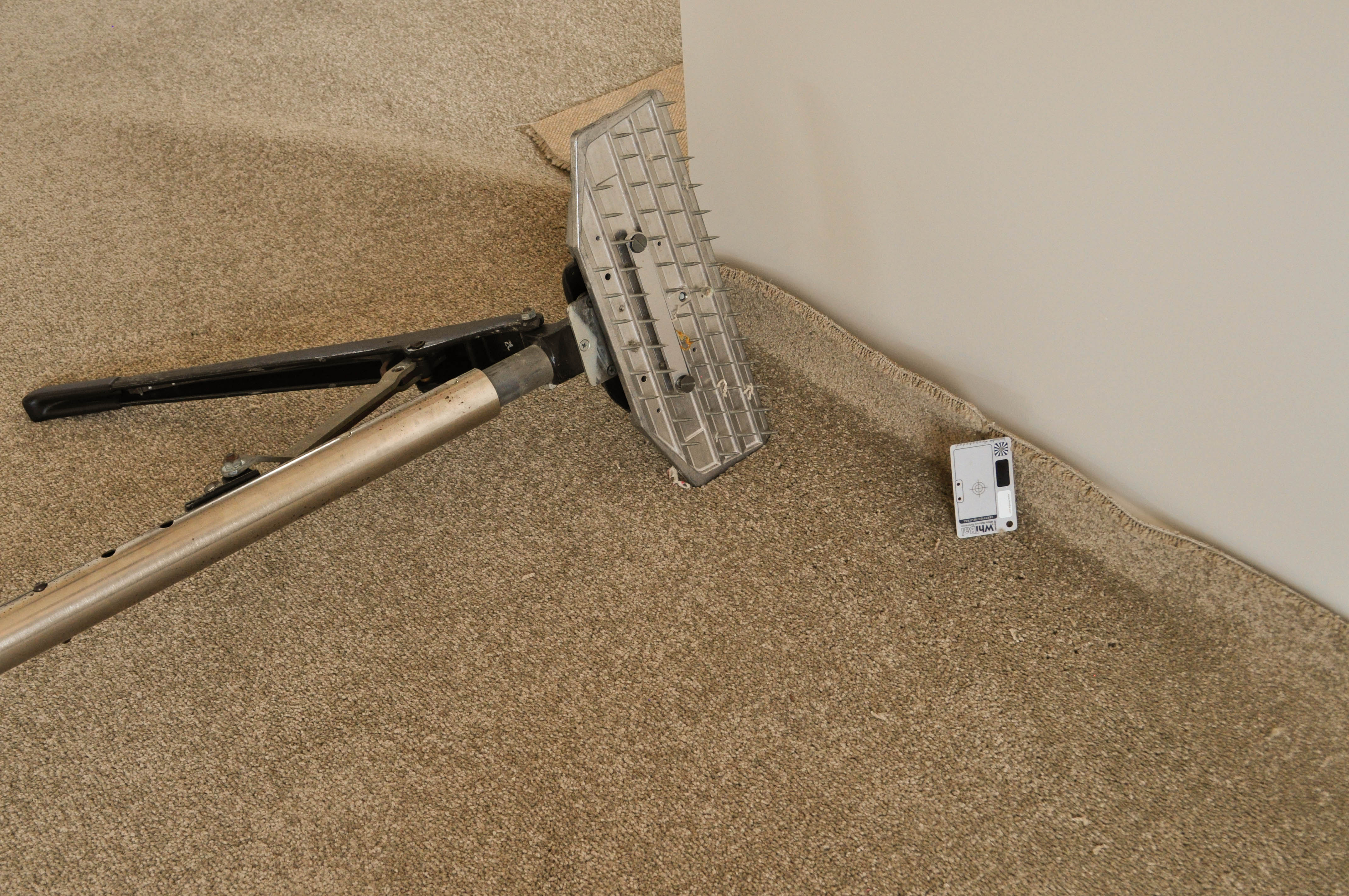

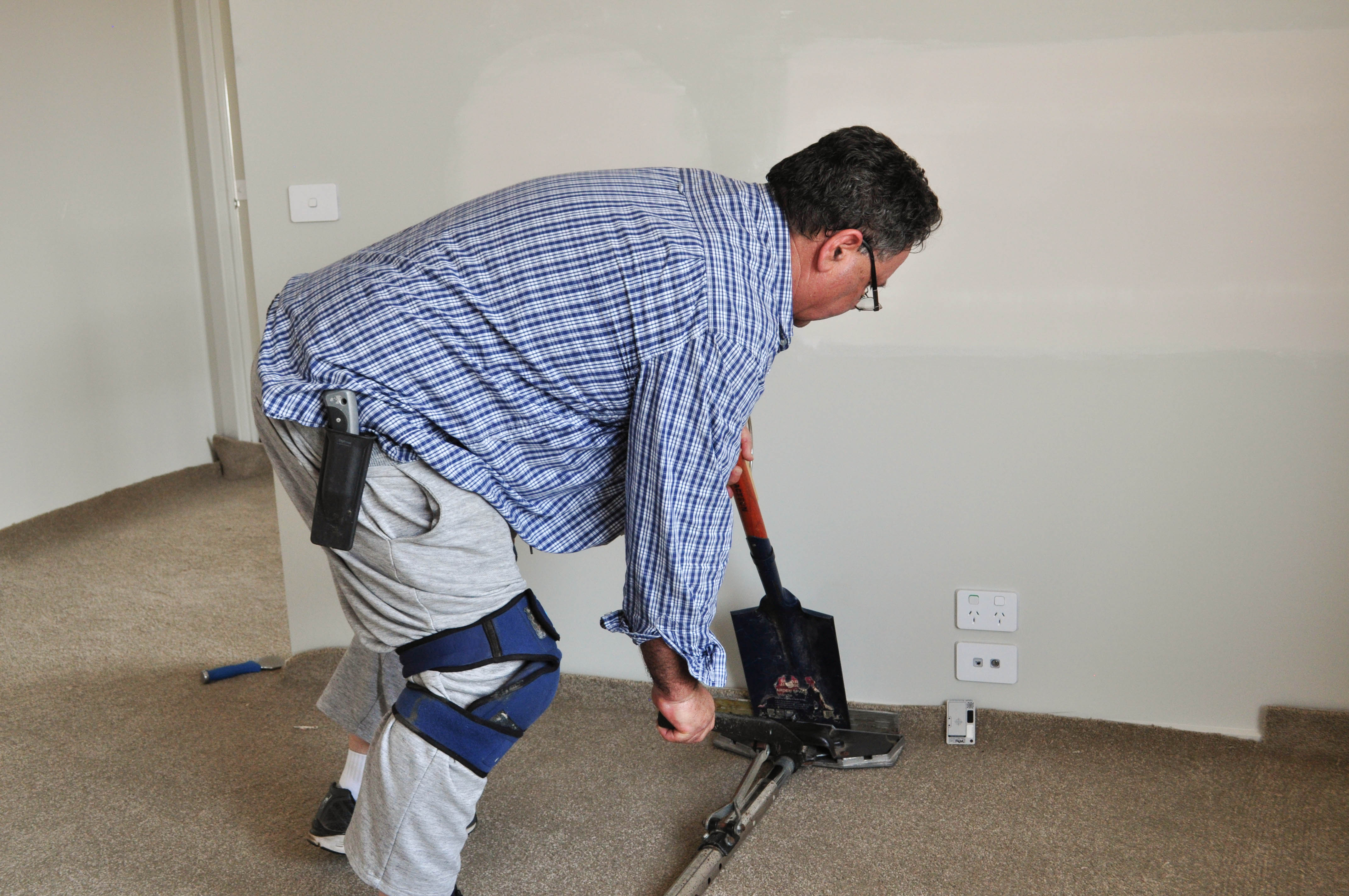
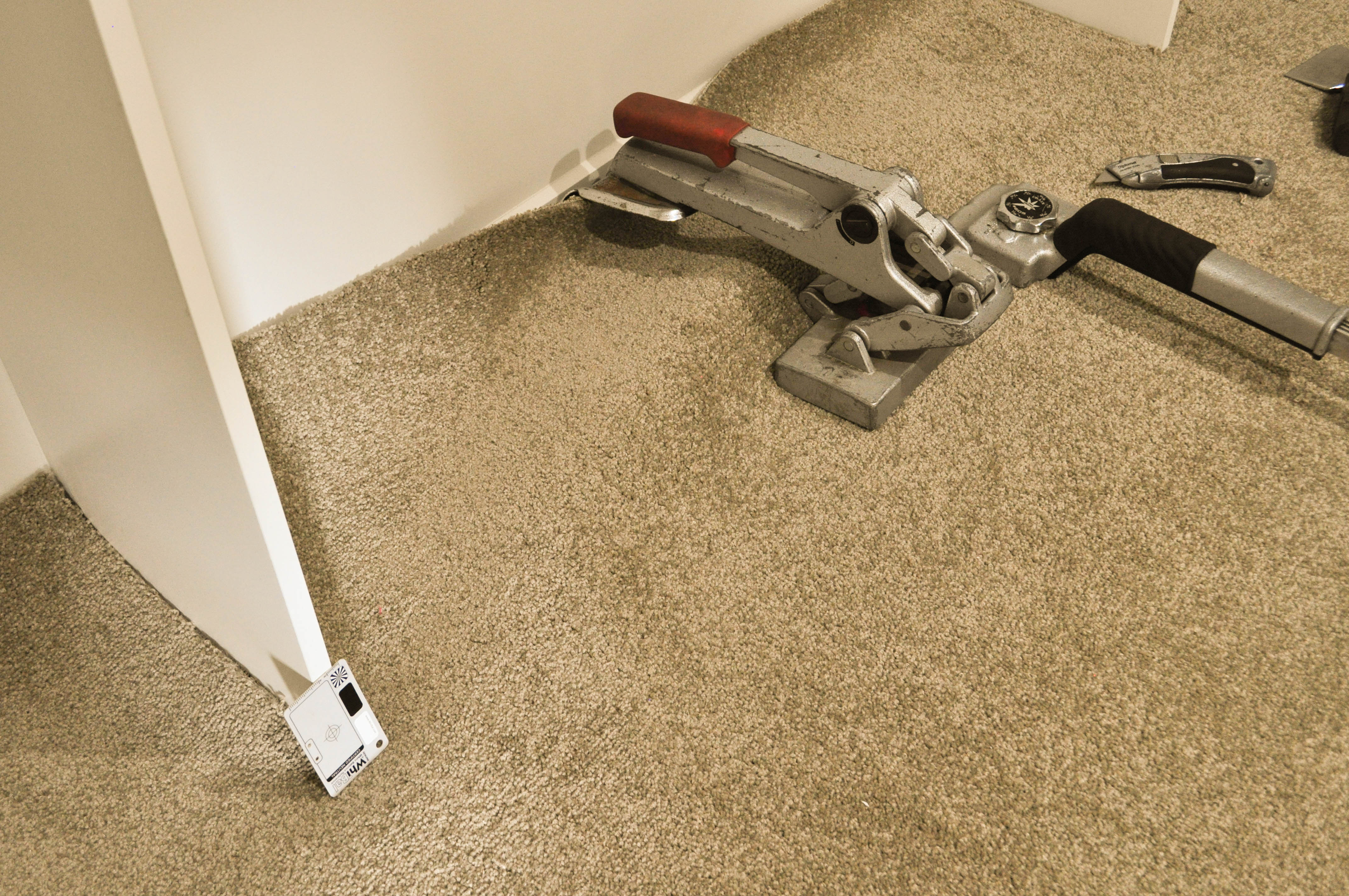

Place the foot of the telescopic power stretcher at one end of the room and the head of the power stretcher at the other end.
Using the power stretchers lever stretch the carpet and with another tool impale it on the spikes of the gripper where it will remain permanently. Cut of the carpet that has risen up the wall and tuck in the carpet into the crotch between the wall and the gripper.
Another techique is to use the tubeless power stretcher, called the "bulldog". Stretch the carpet by means of the bulldog's lever and using the knee kicker impale the carpet onto the gripper's spikes.
Do you live in Hoppers Crossing, Werribee, Derrimut, Altona, Altona meadows, Tarneit, Truganina, Caroline Springs, Williamstown, Newport or surrounding suburbs, and require the services of a carpet layer to lay your new carpet or do re-stretches or perform repairs on your existing carpet? If so you are within 30 minutes drive from our business premises. You are located close to us and for us travelling time to your job will be minimal and you will not be charged travelling time.
Any work that concord Floors performs carries with it a 12 month warranty and that it will be executed in a tradesmanlike manner meeting government standards.
concord floors has an accredited carpet layer with a "WHITE CARD" CERTIFICATION that he has been successfully trained in the Occupational Health and Safety Act 2004
The following list is a directory of carpet layers that are idependent and in no way associated with Concord Floors, but whose prices are cost effective.